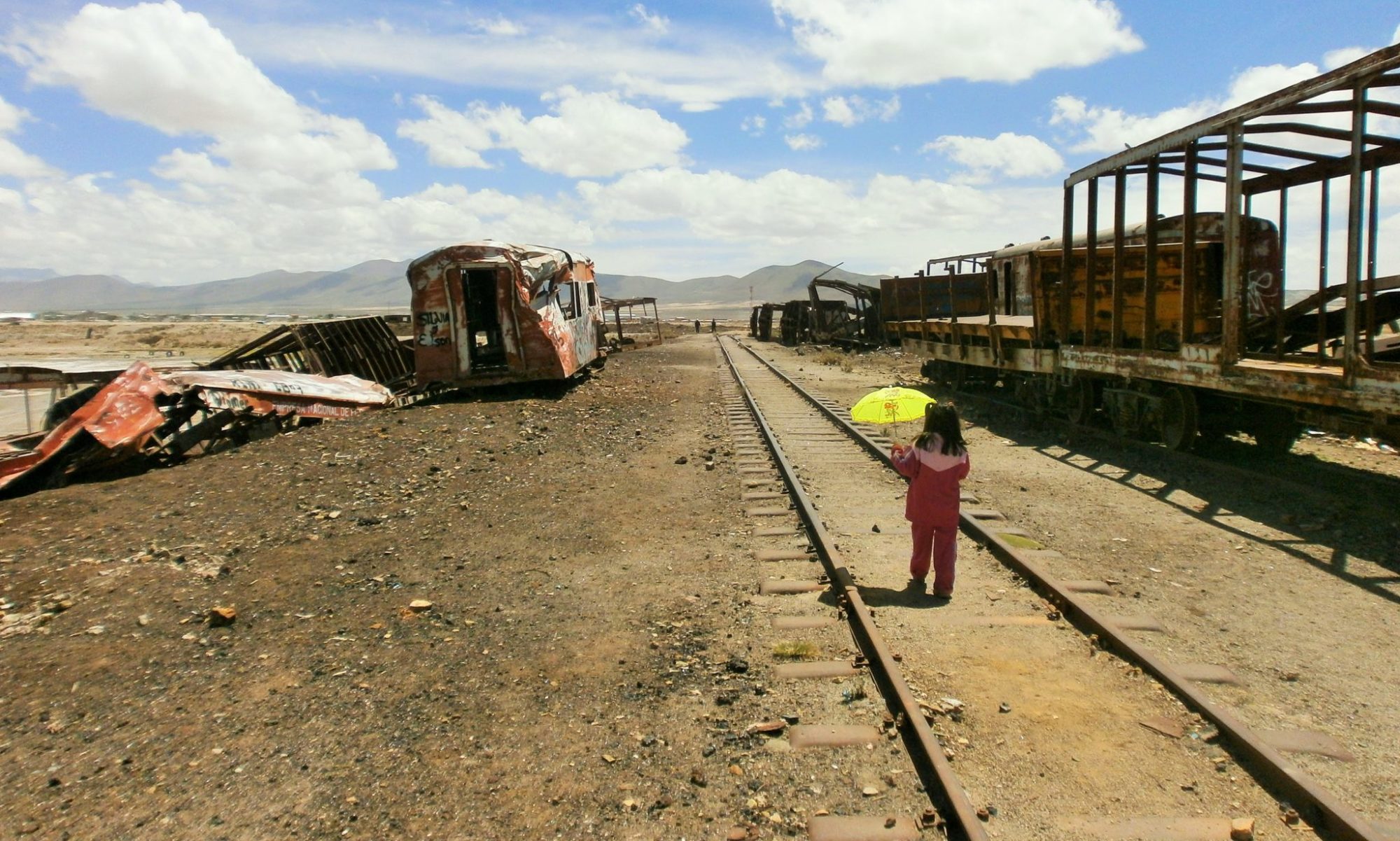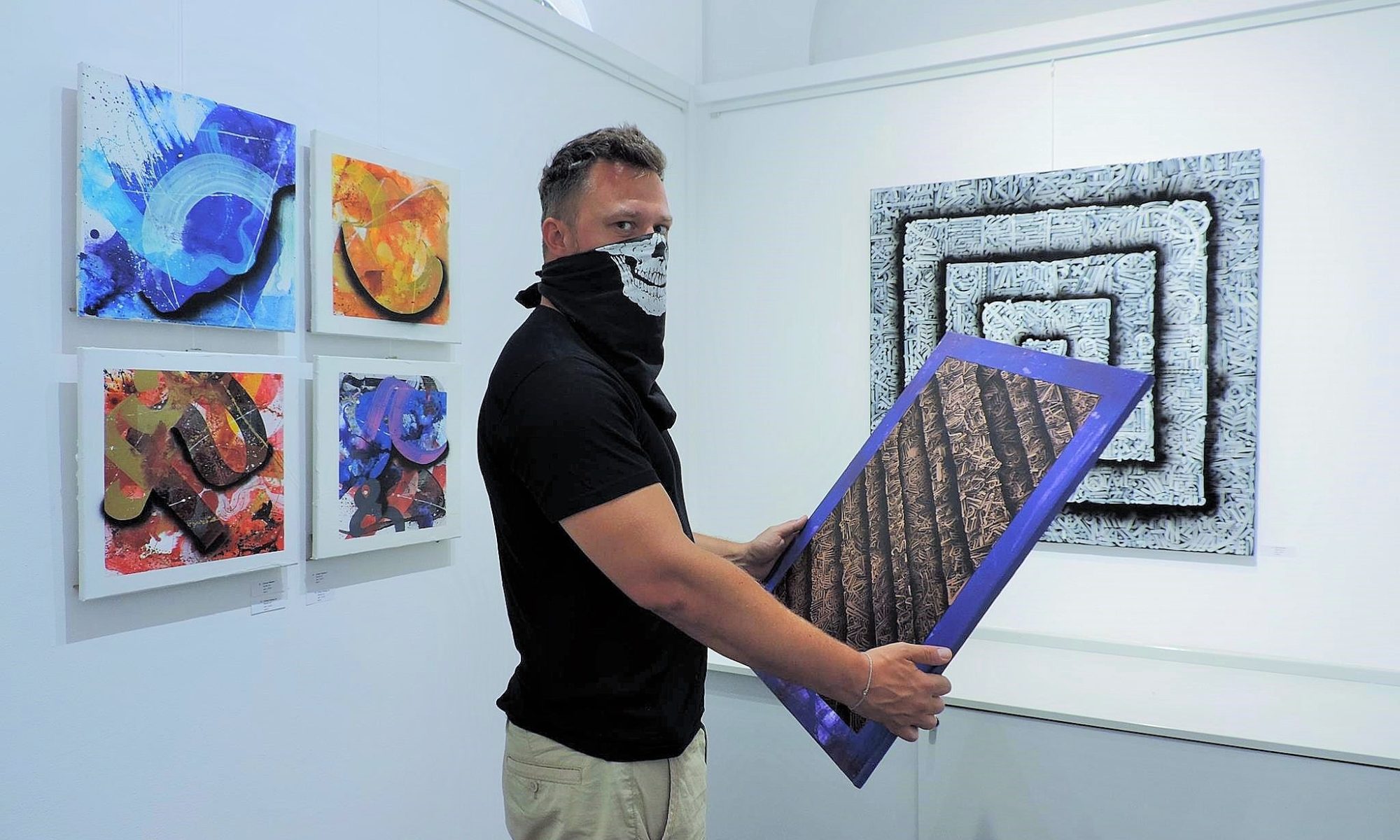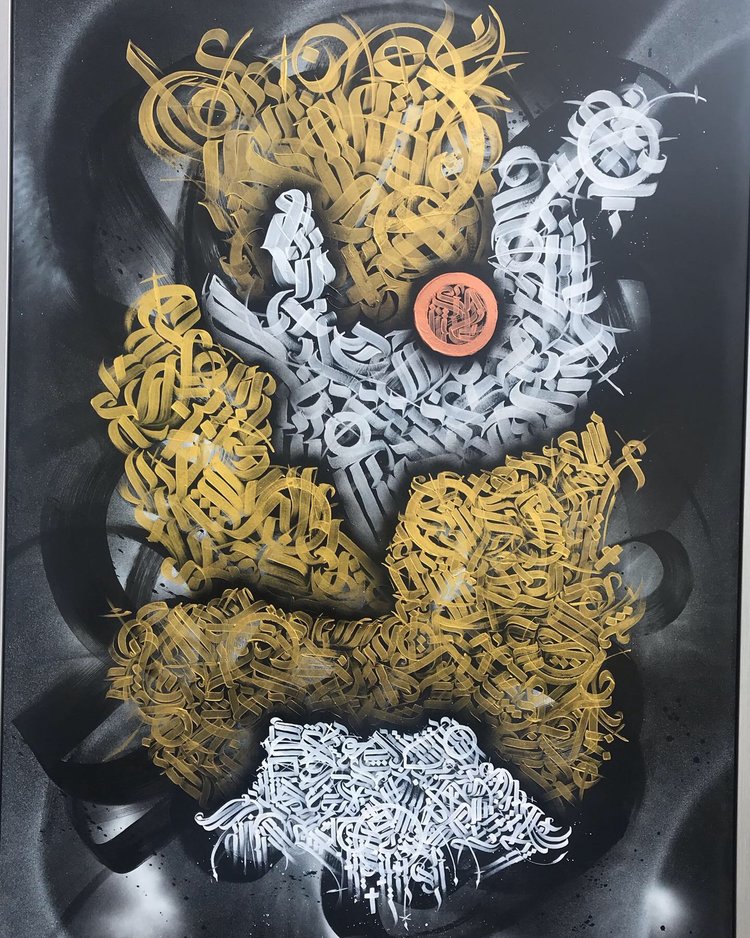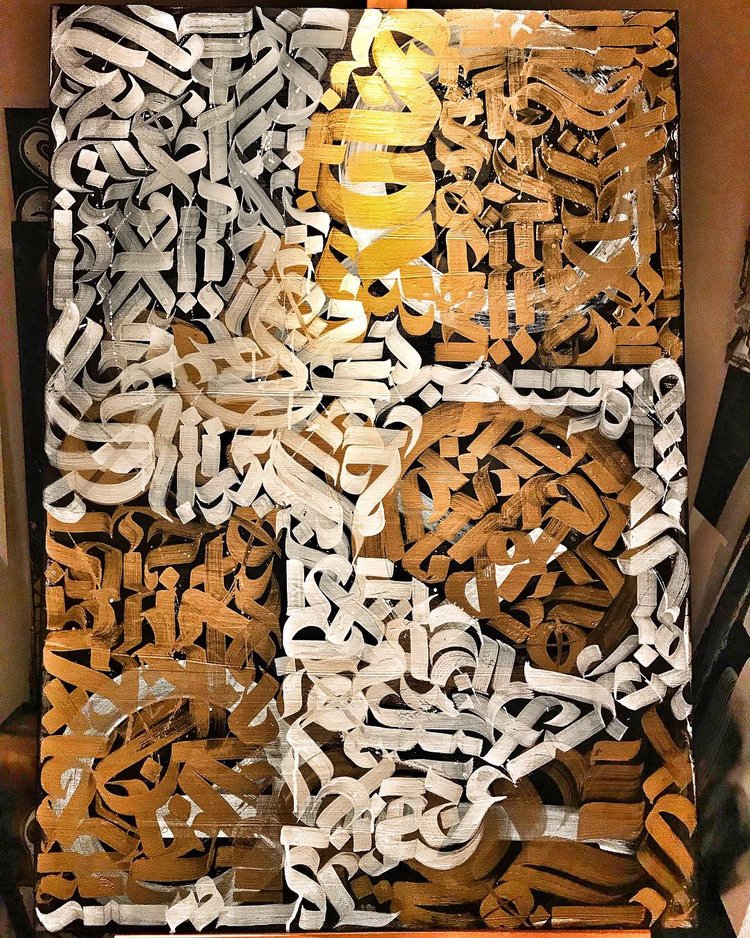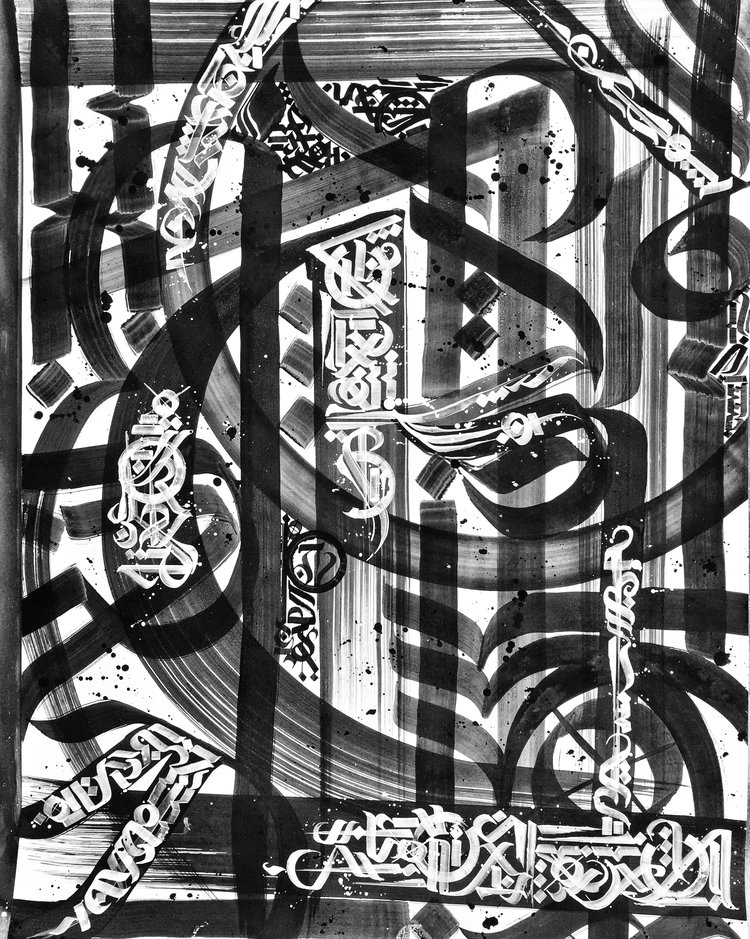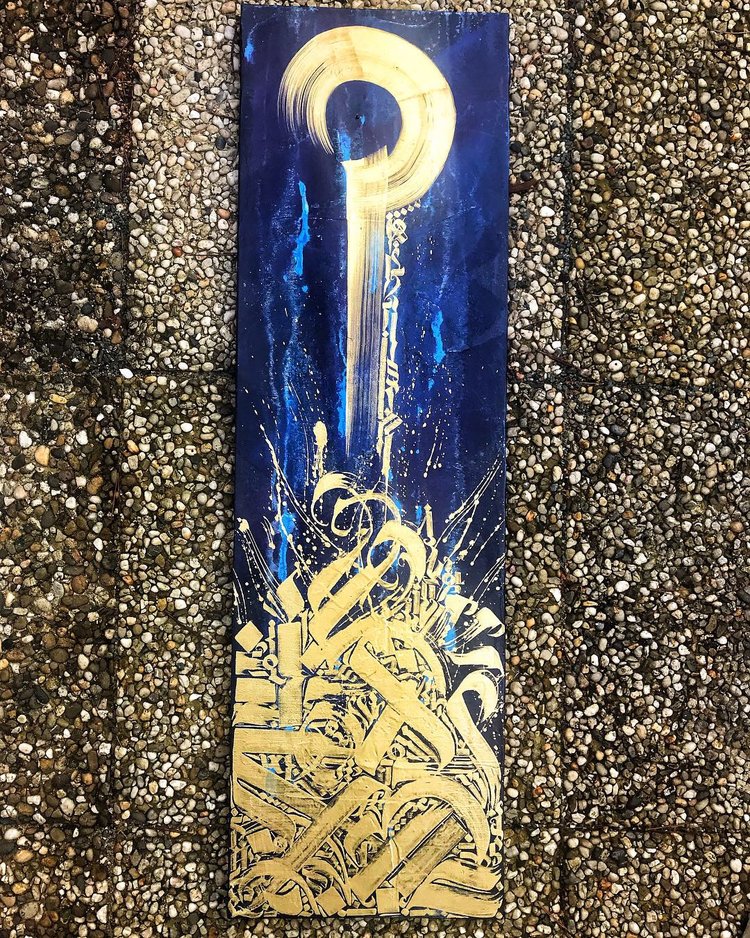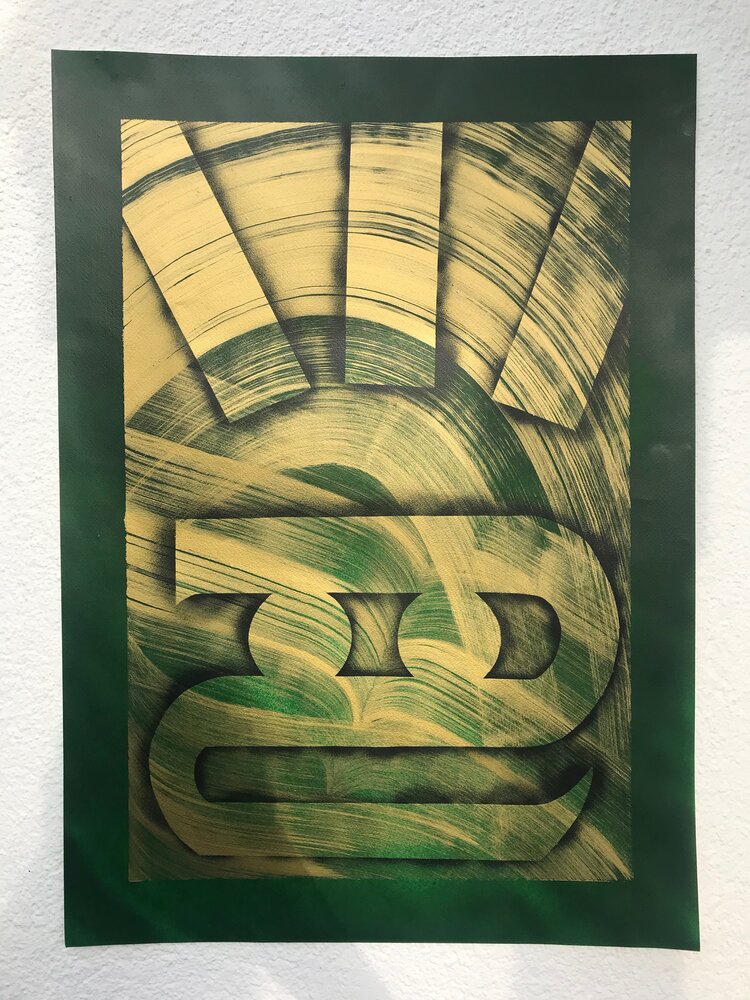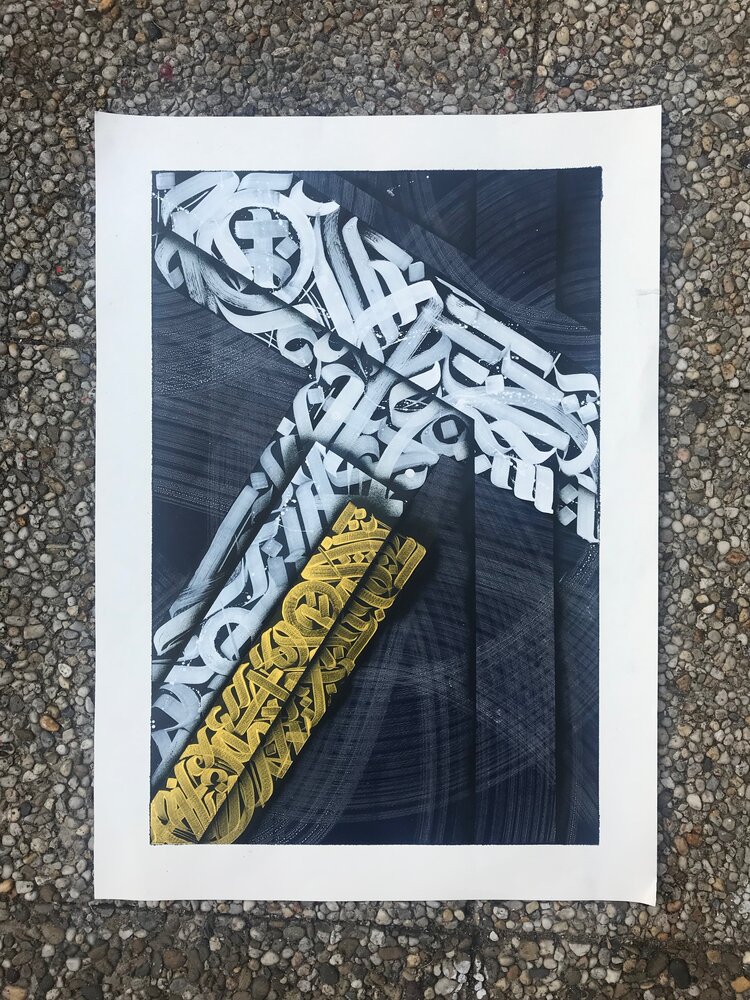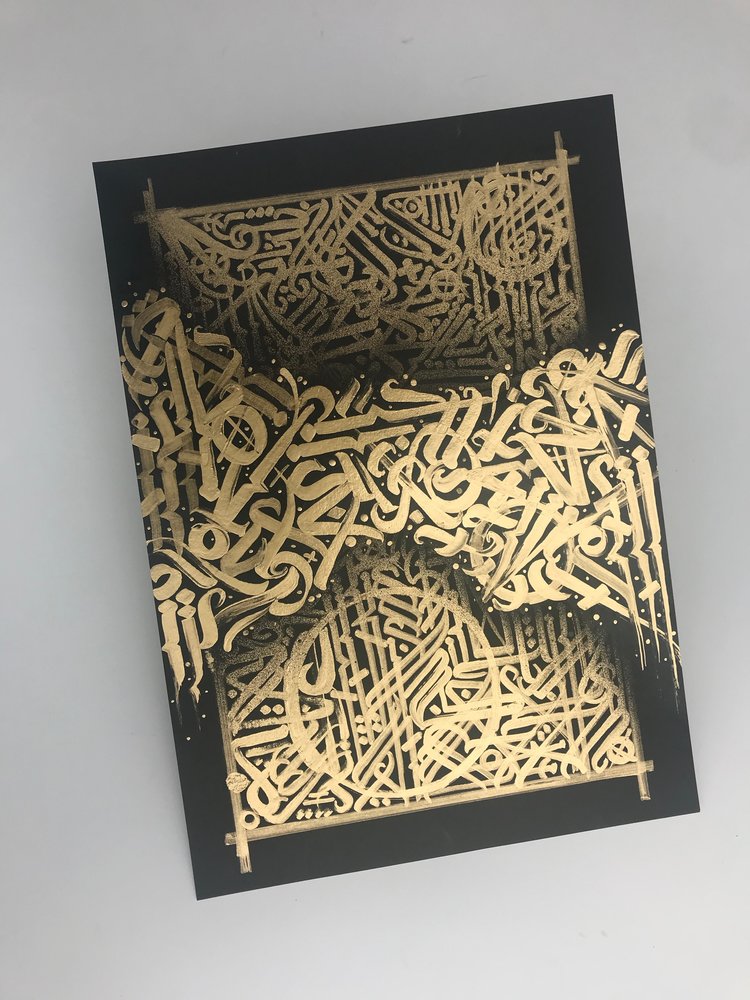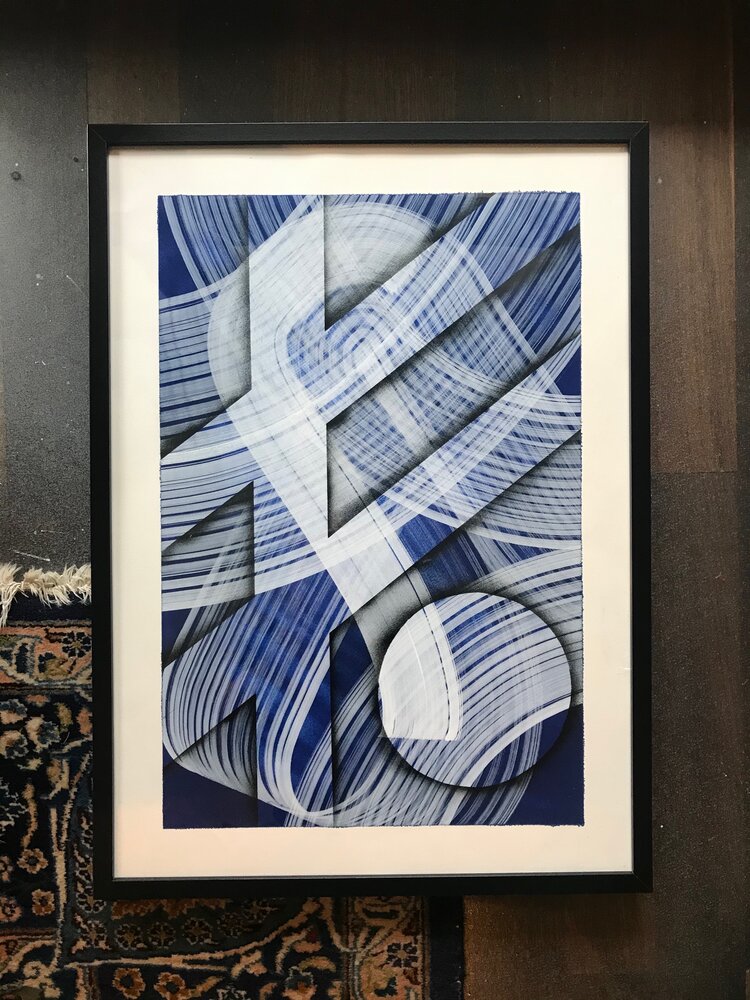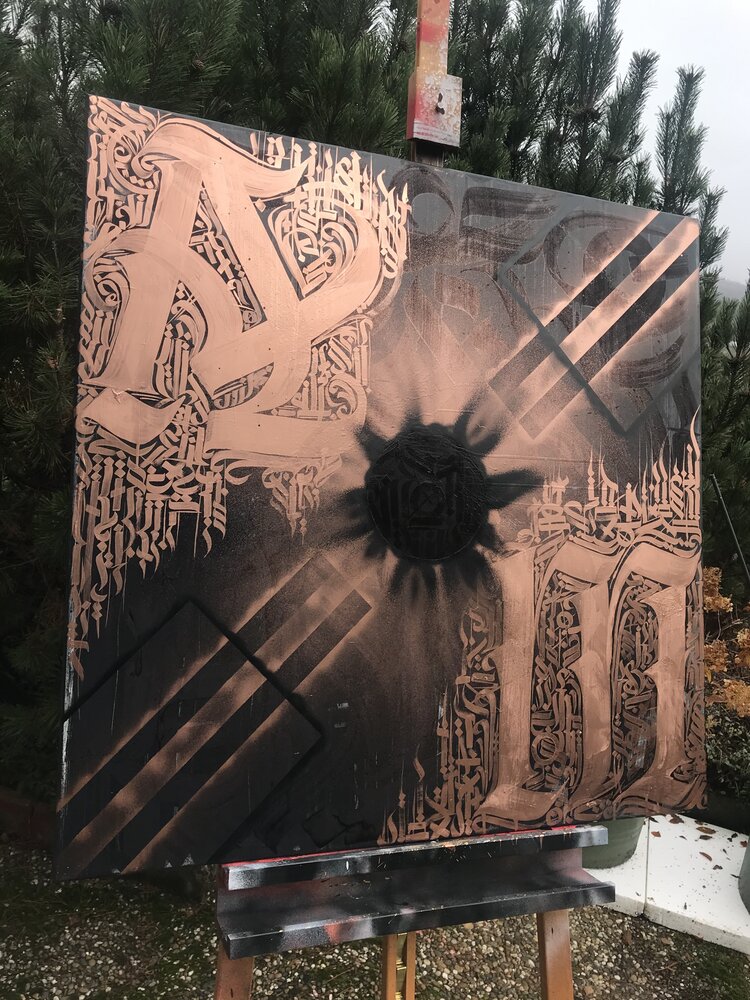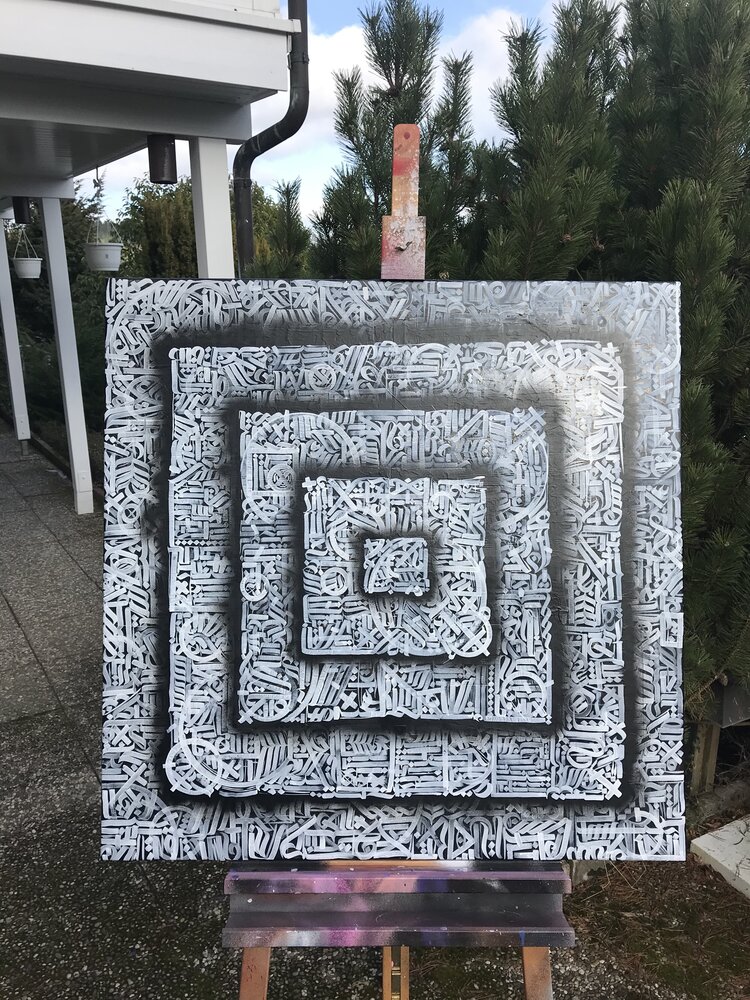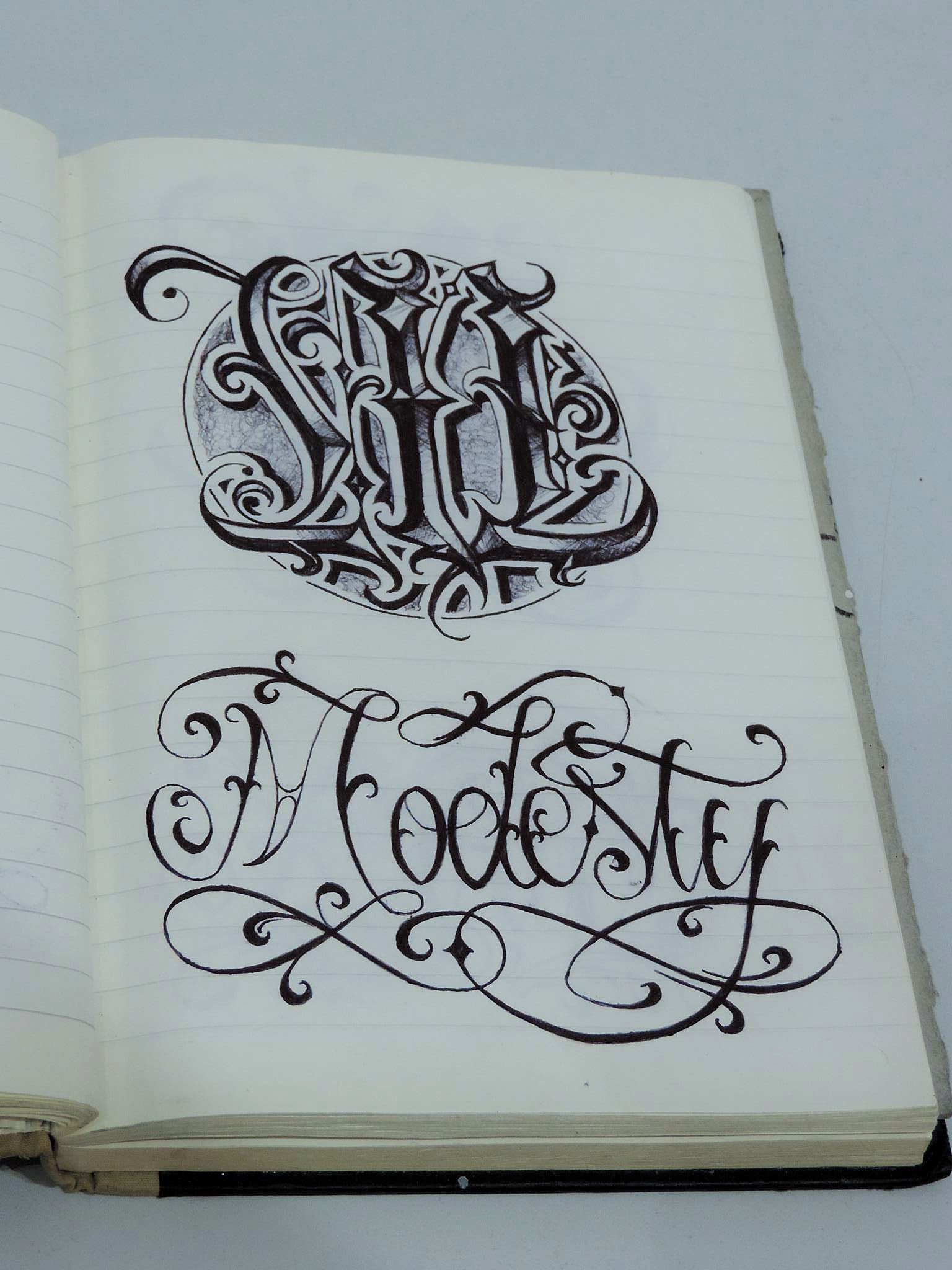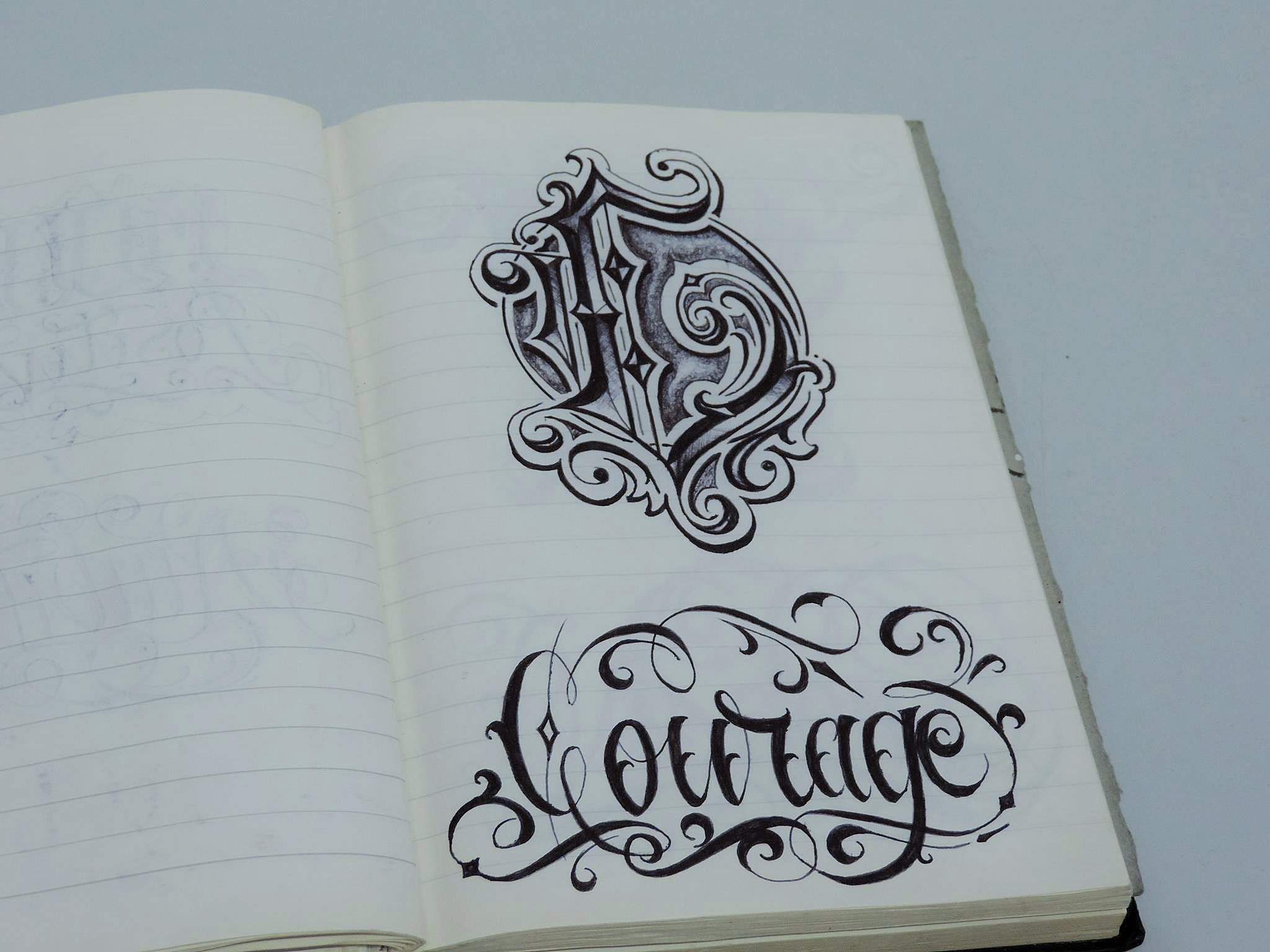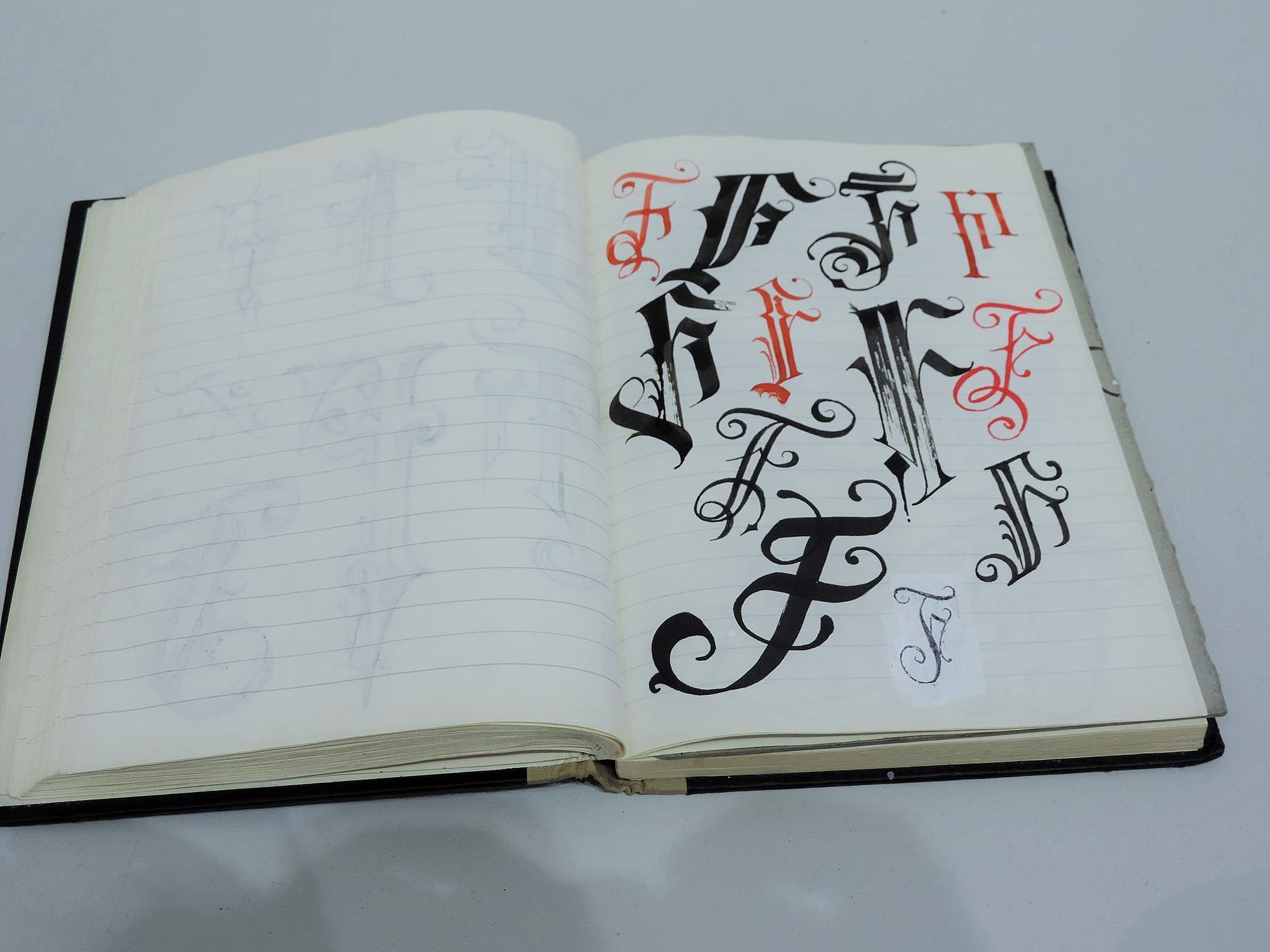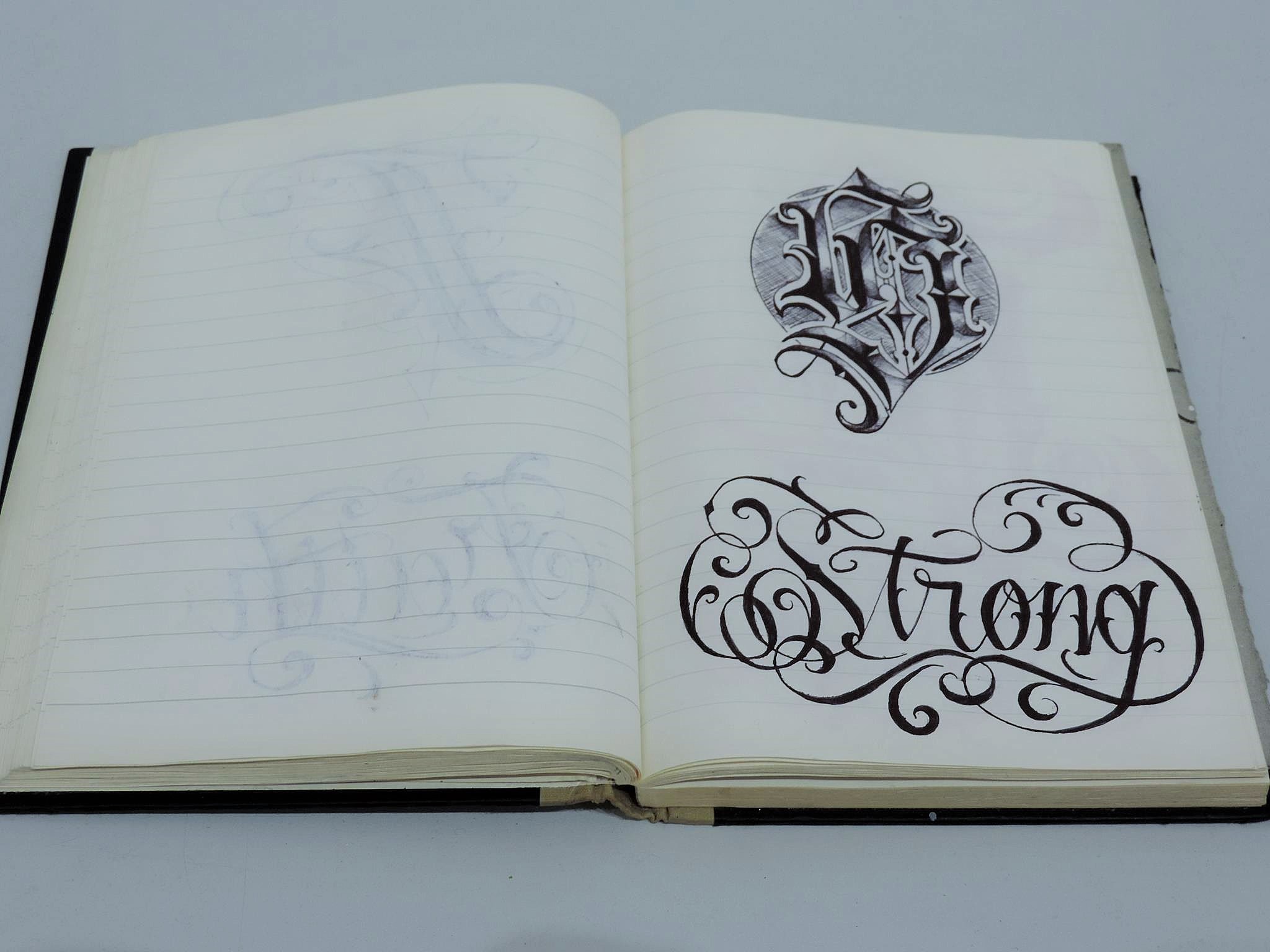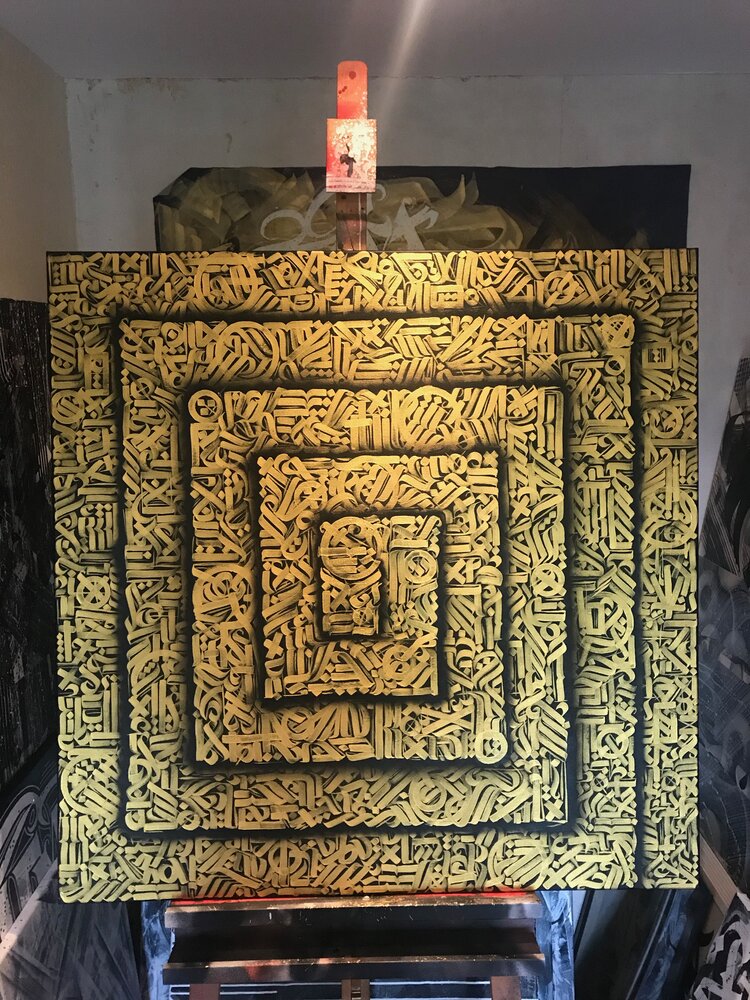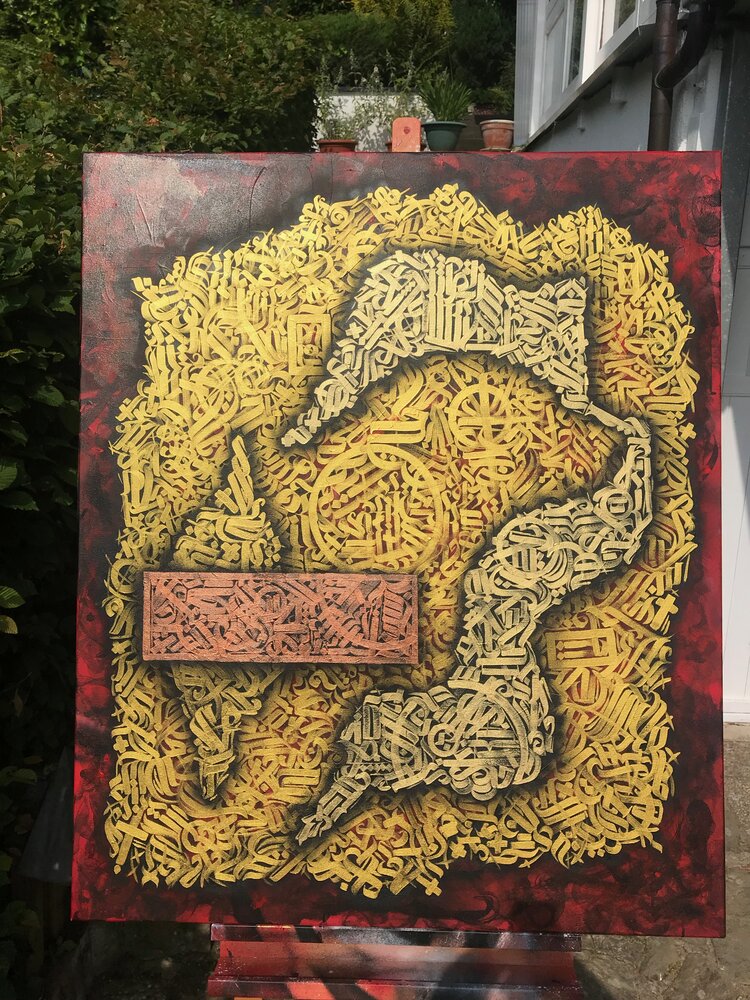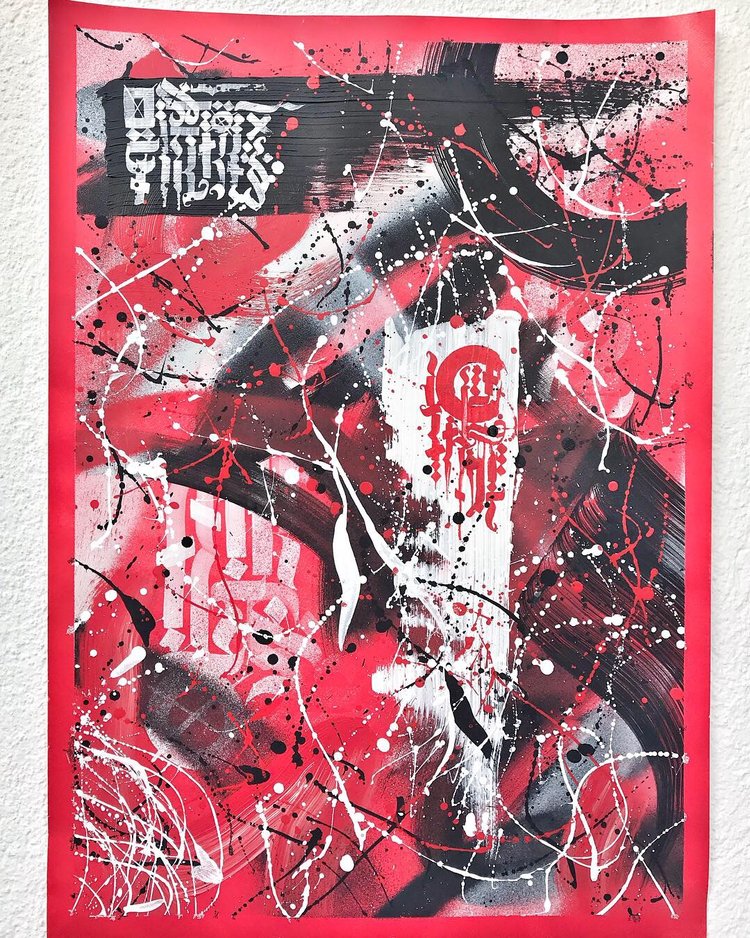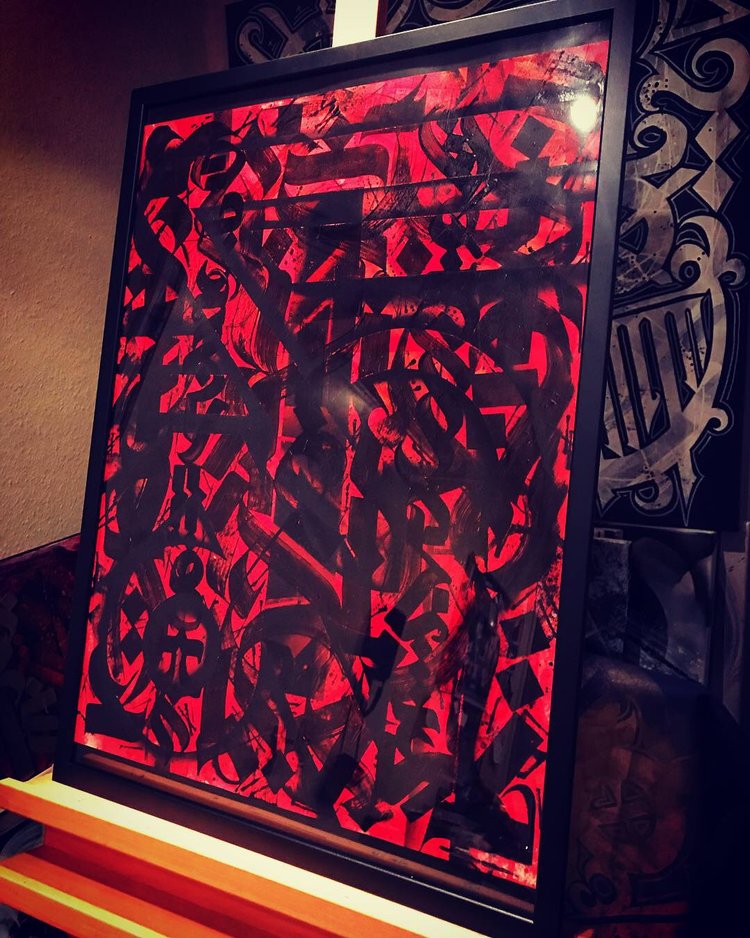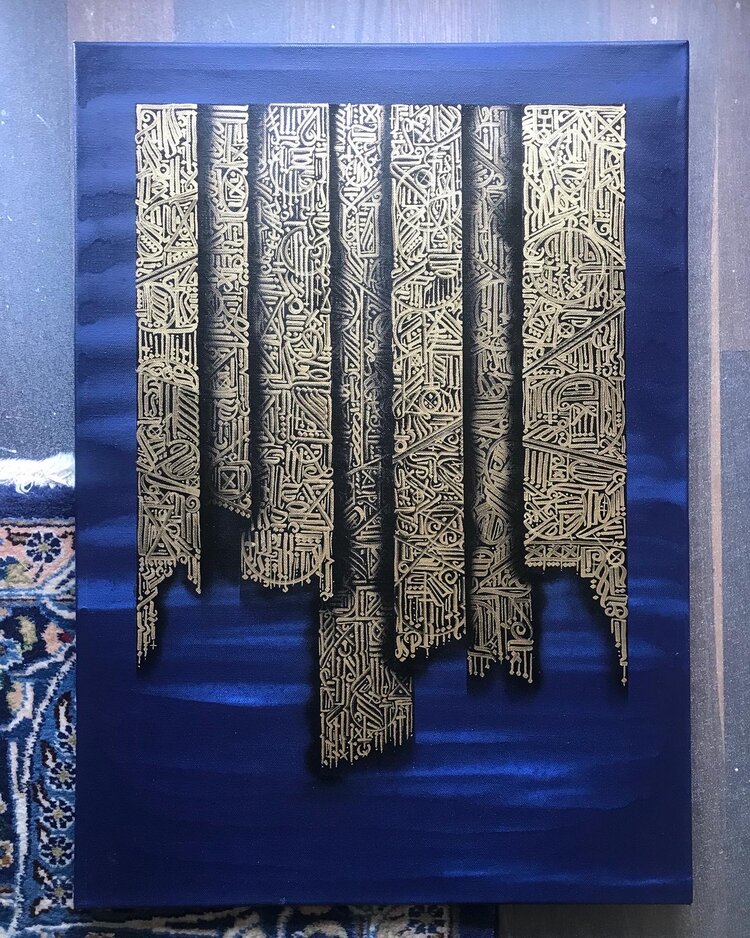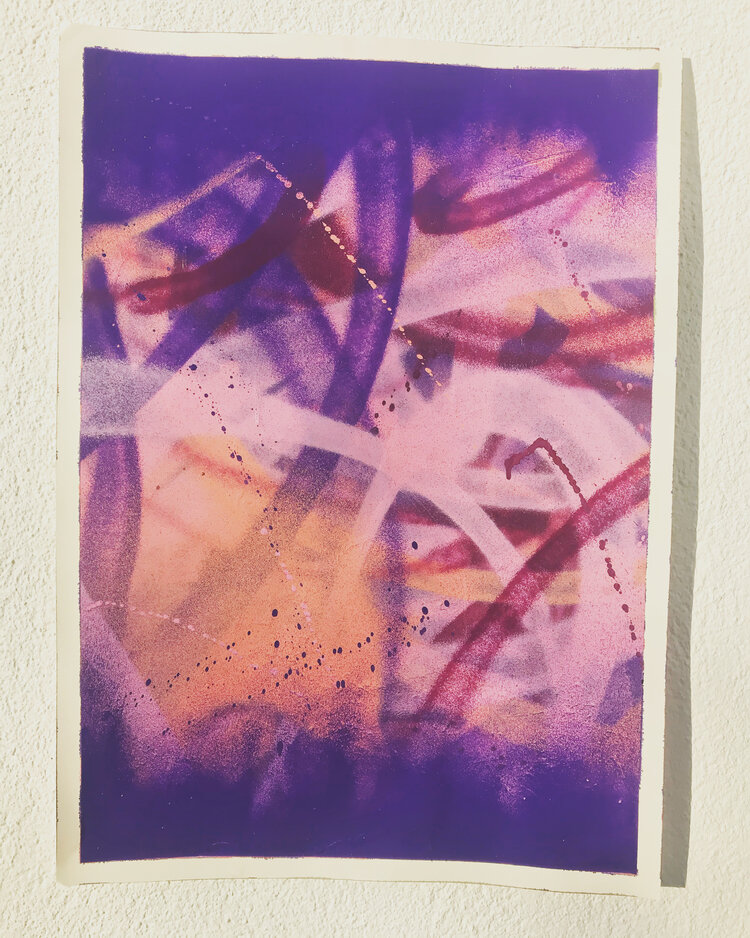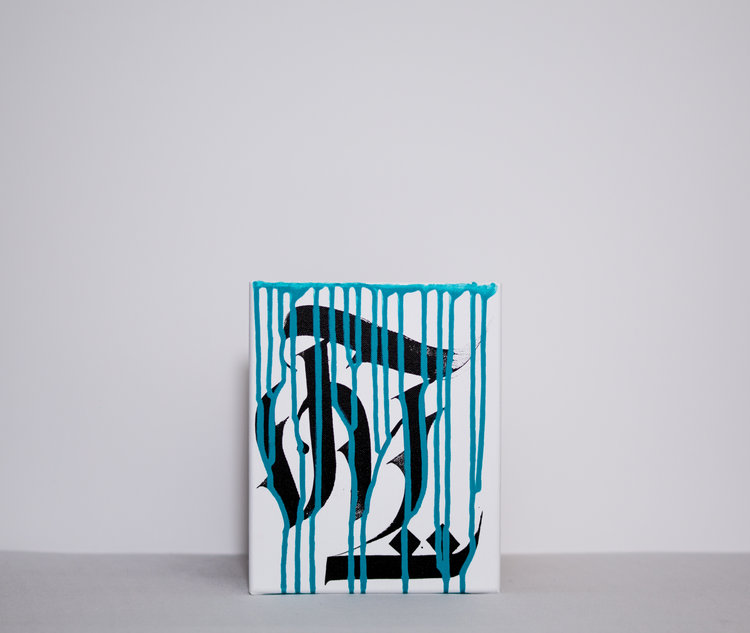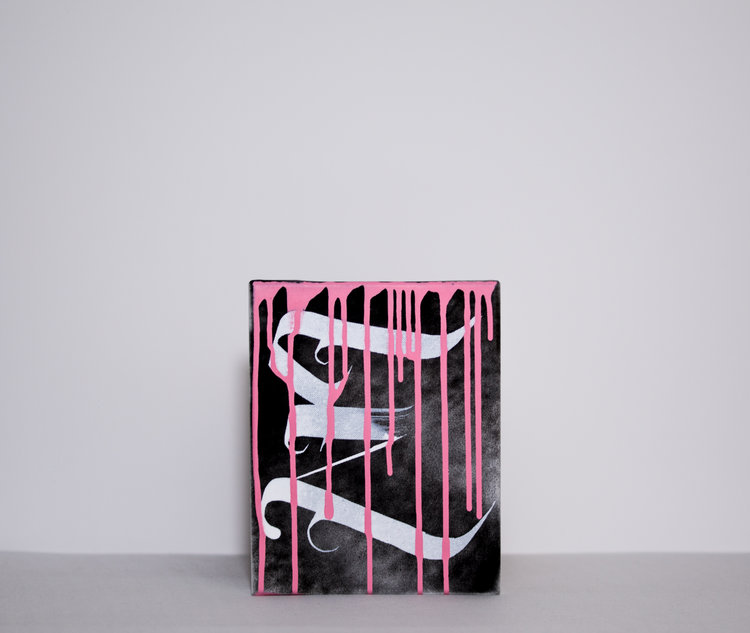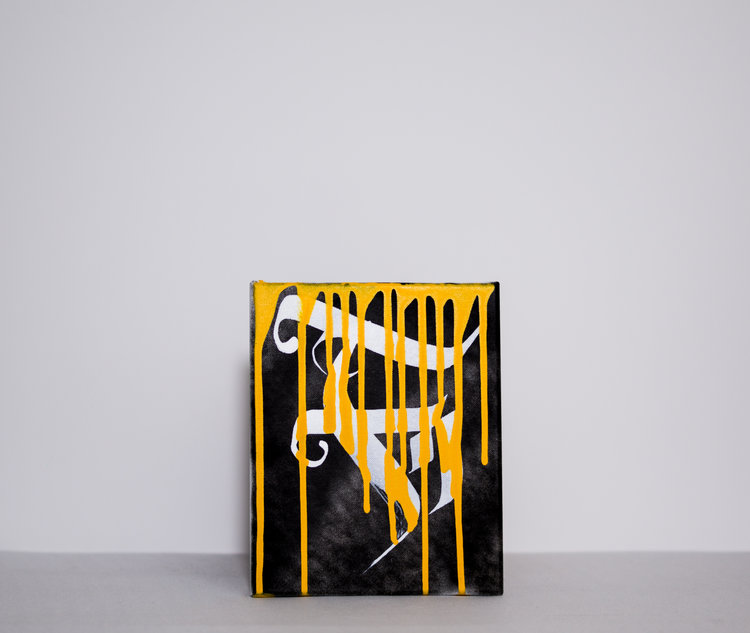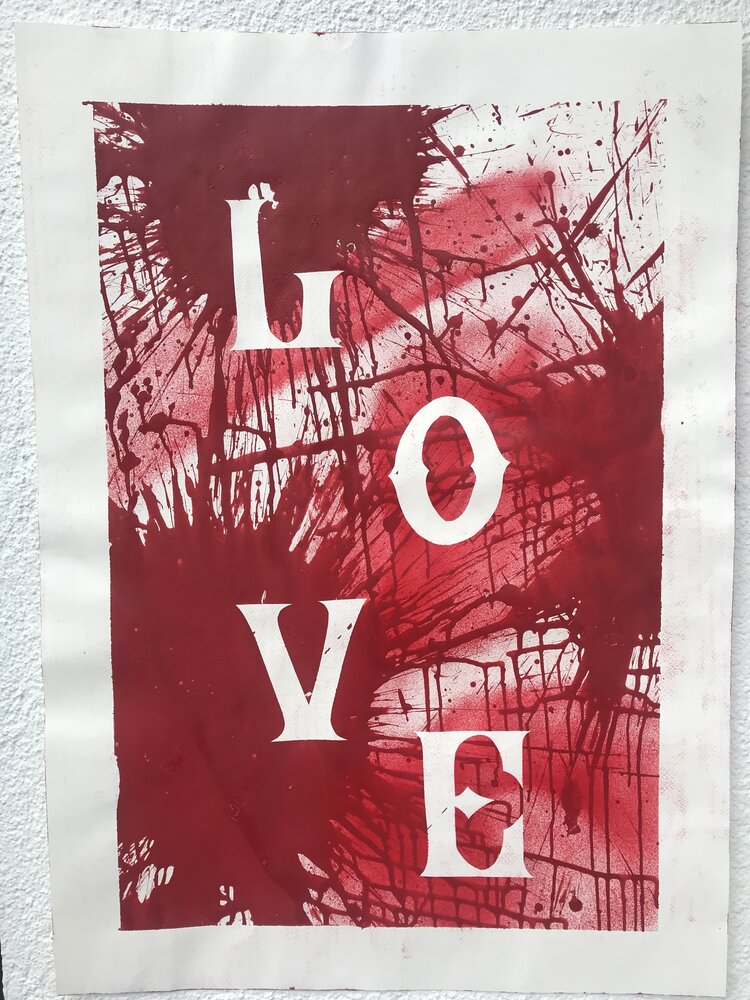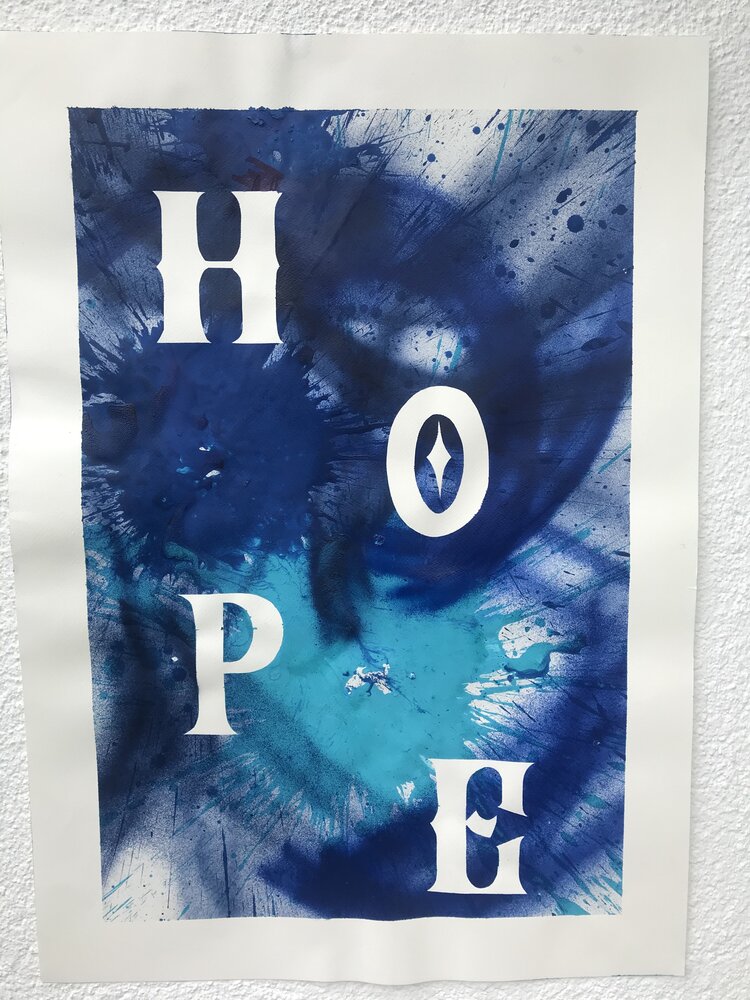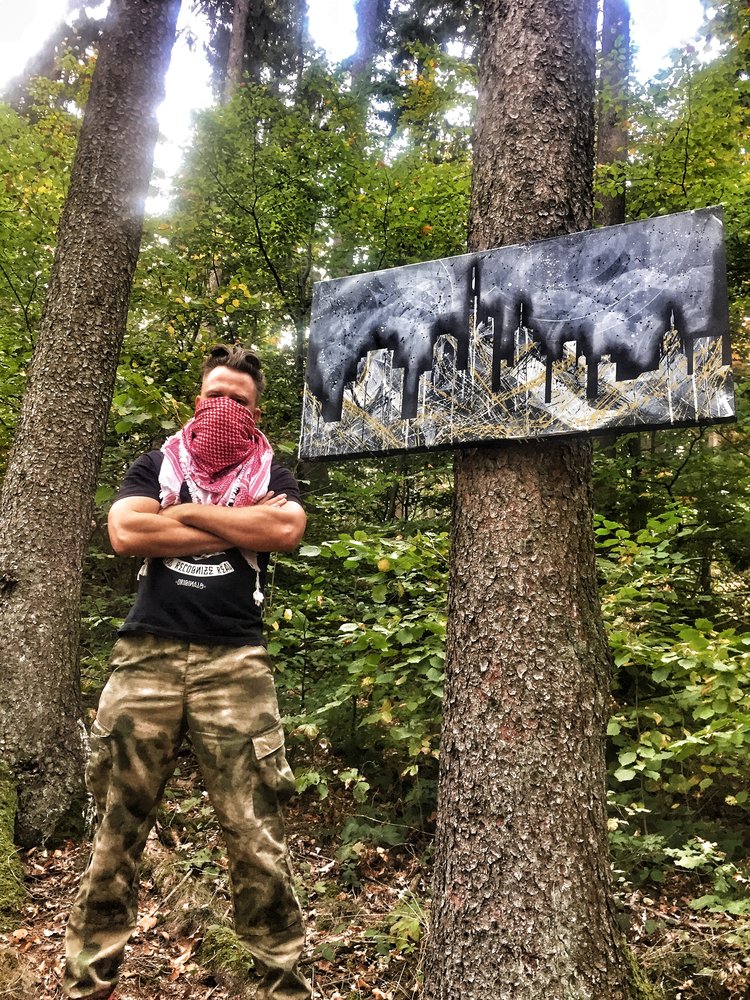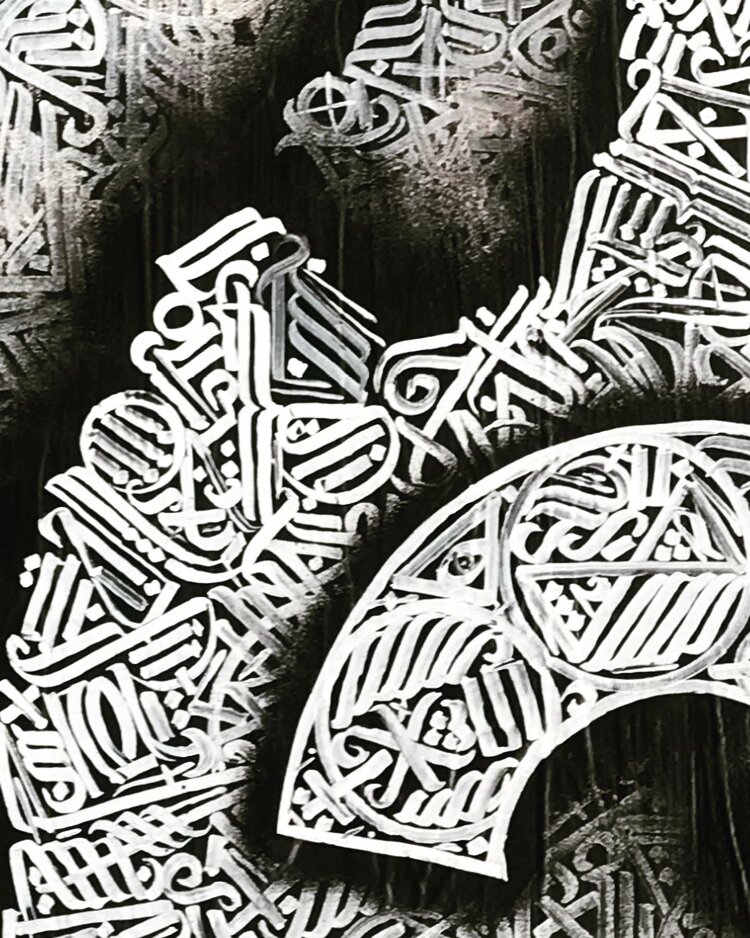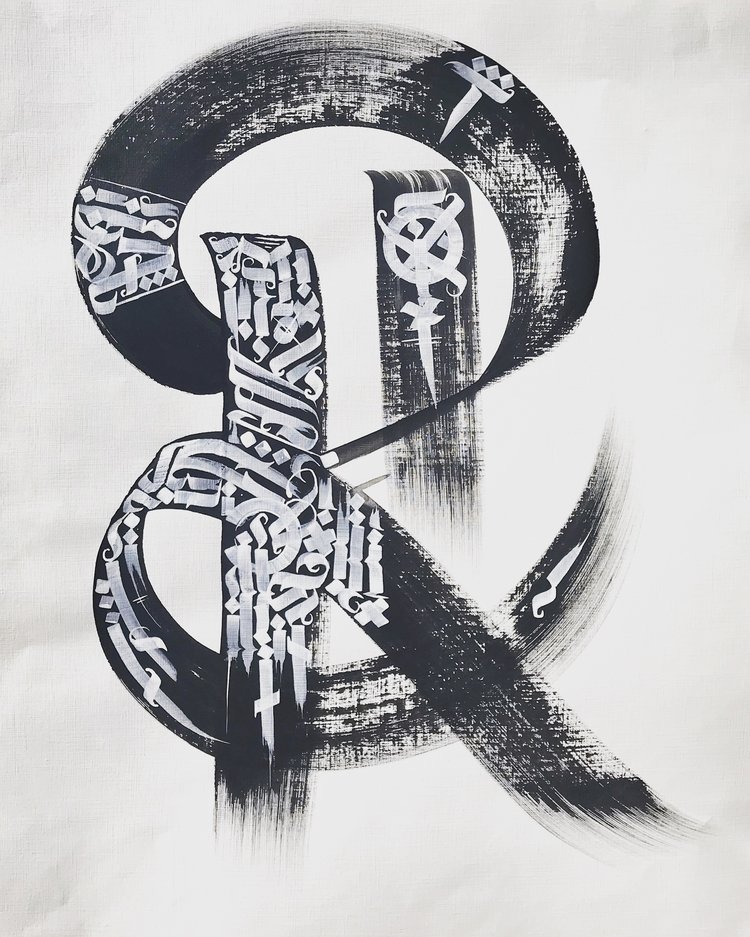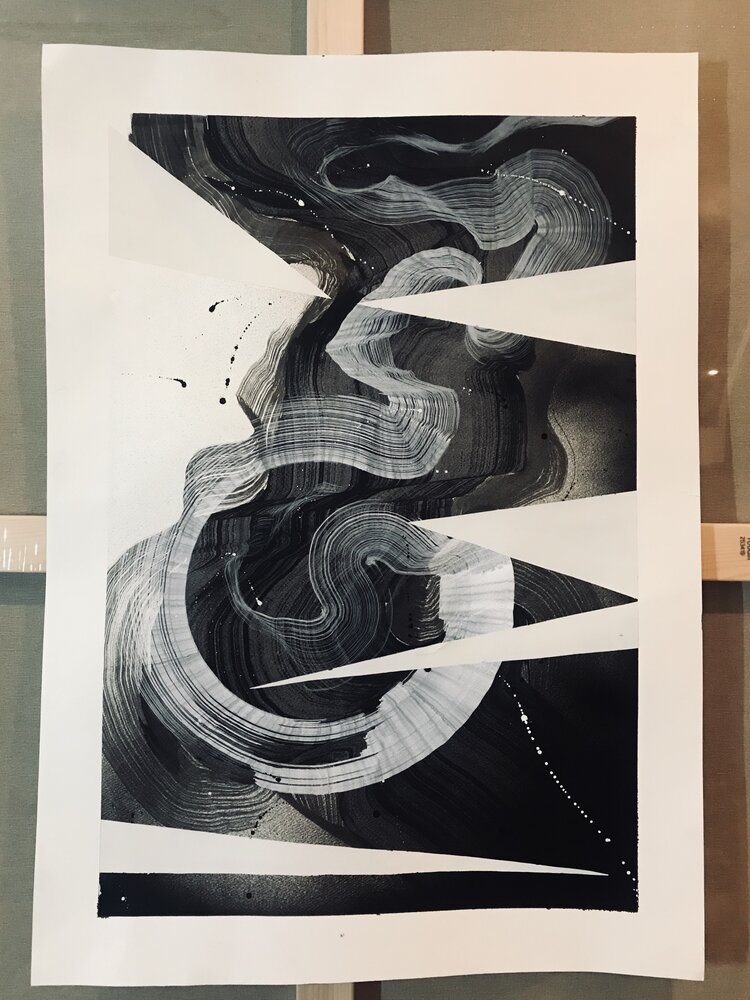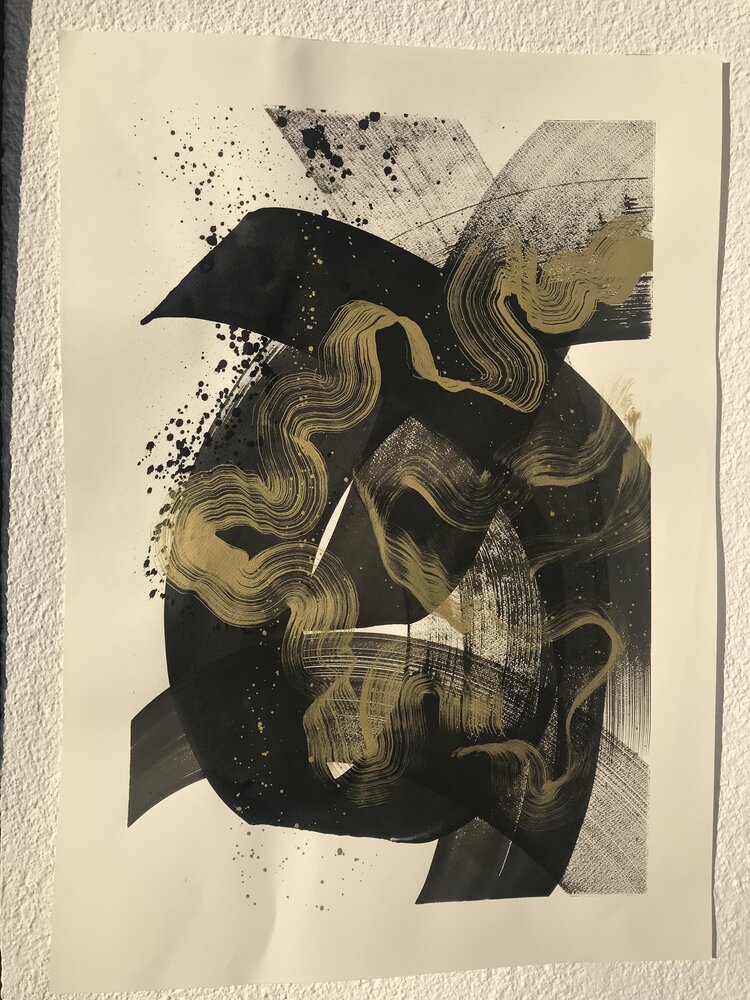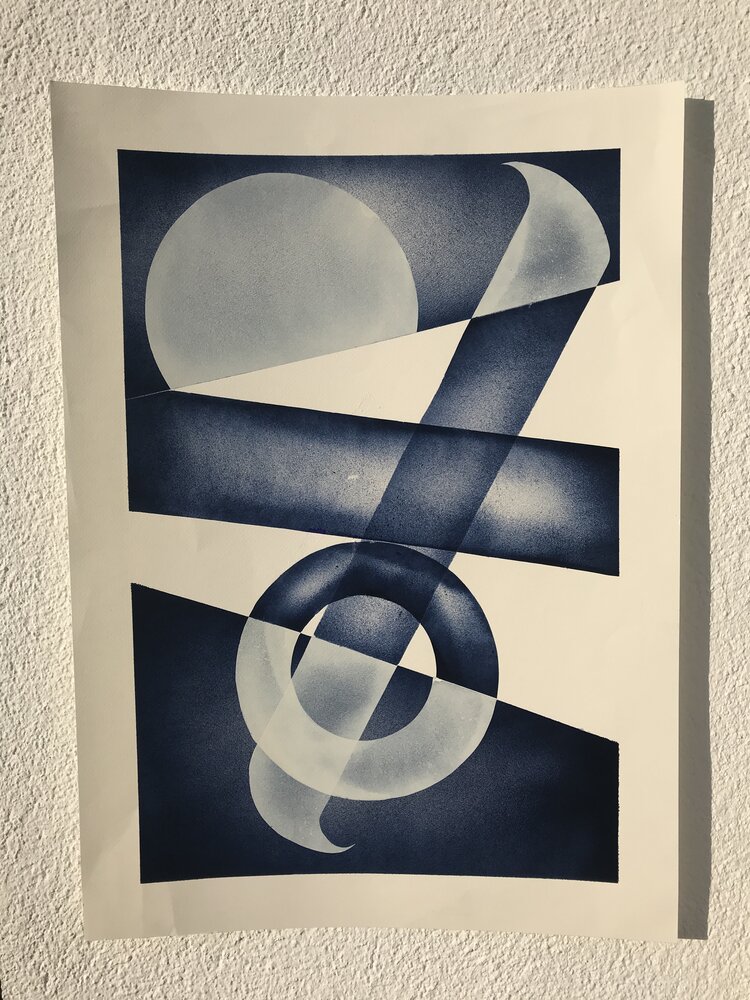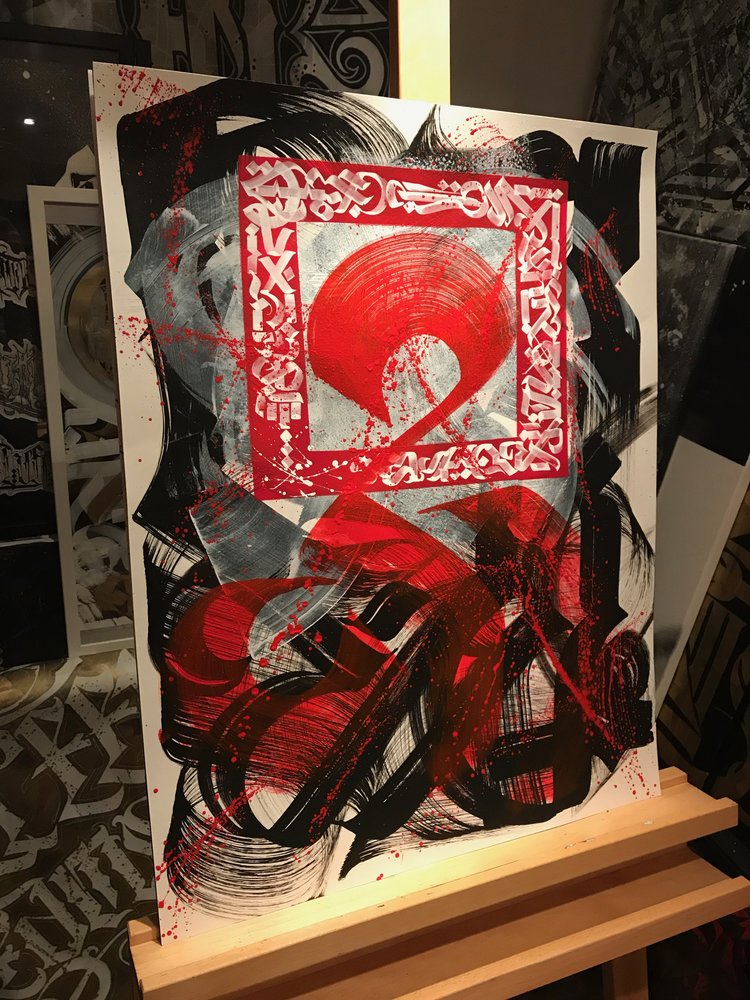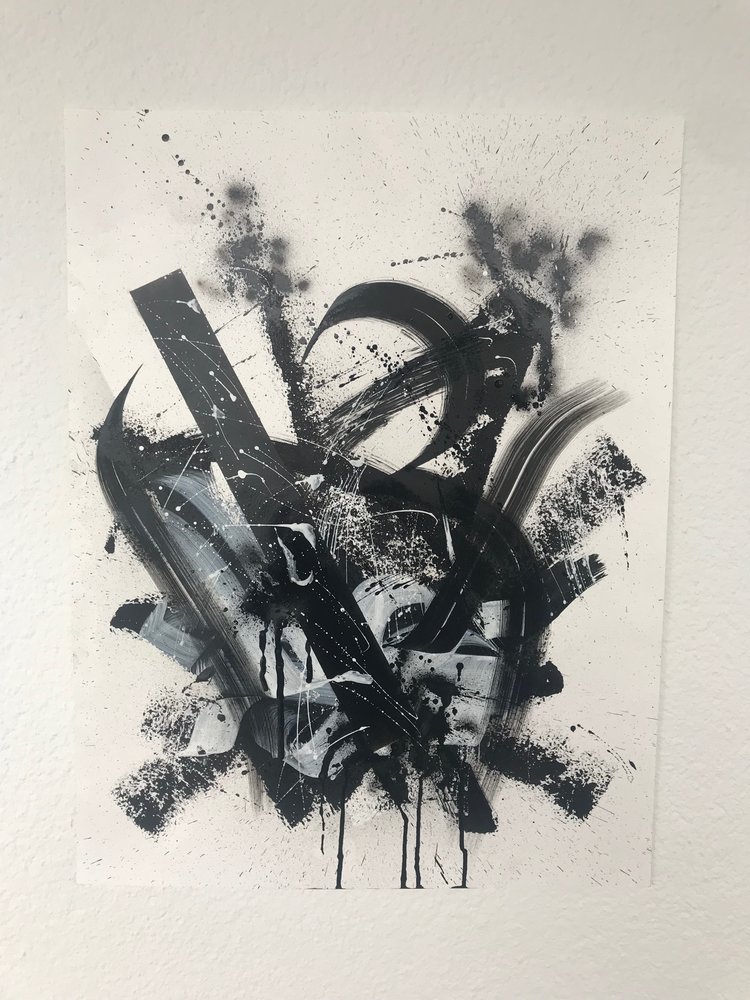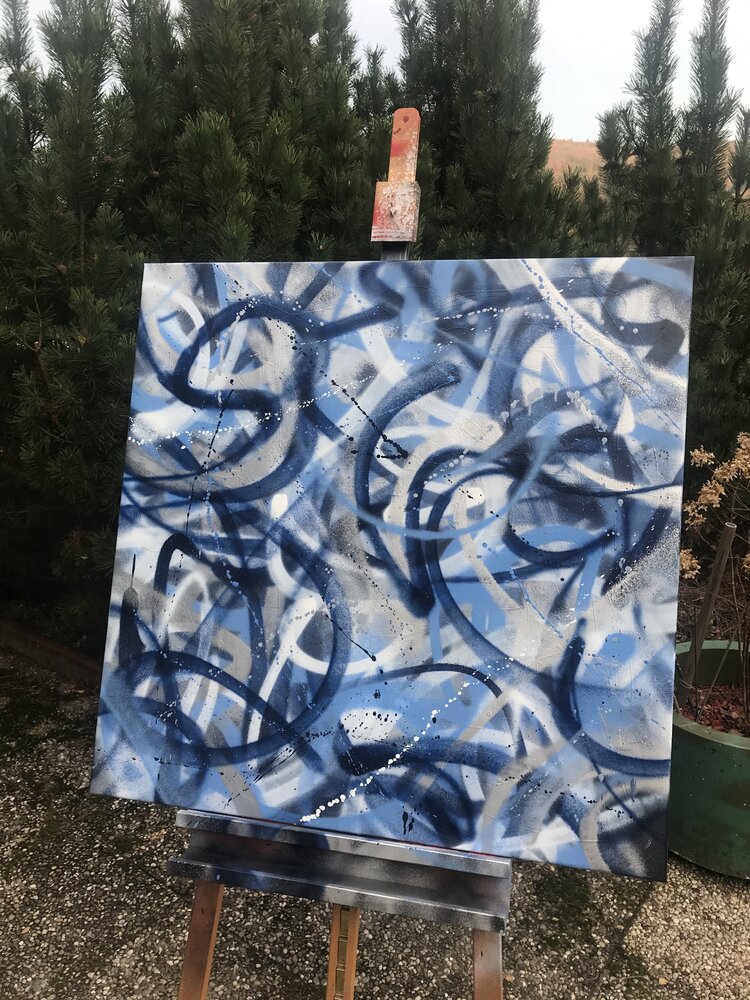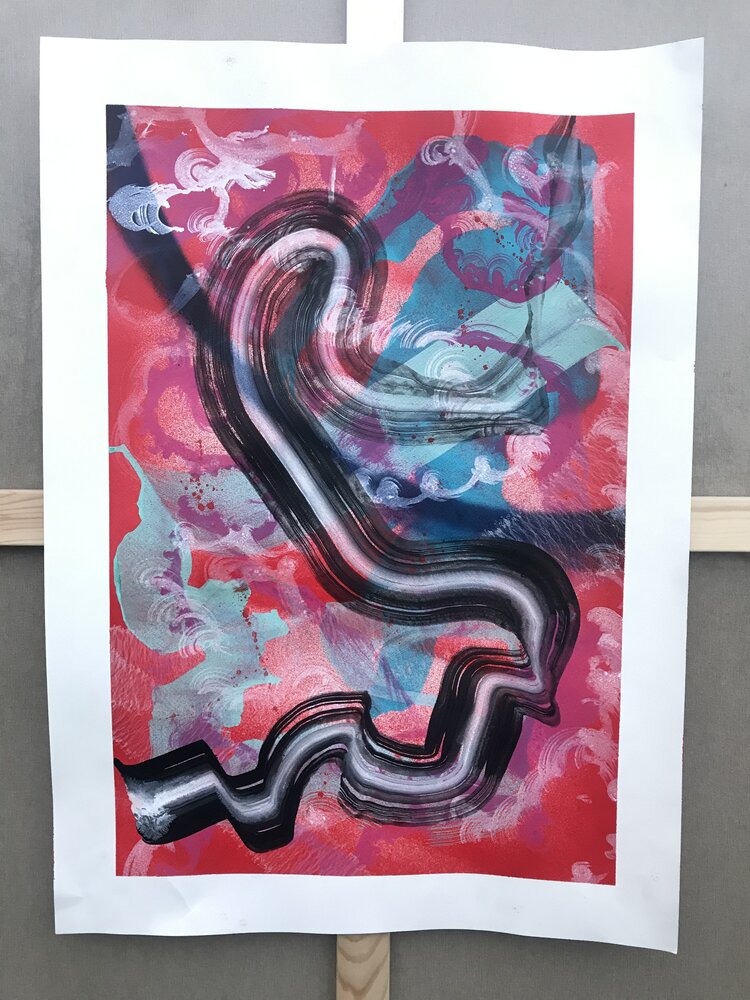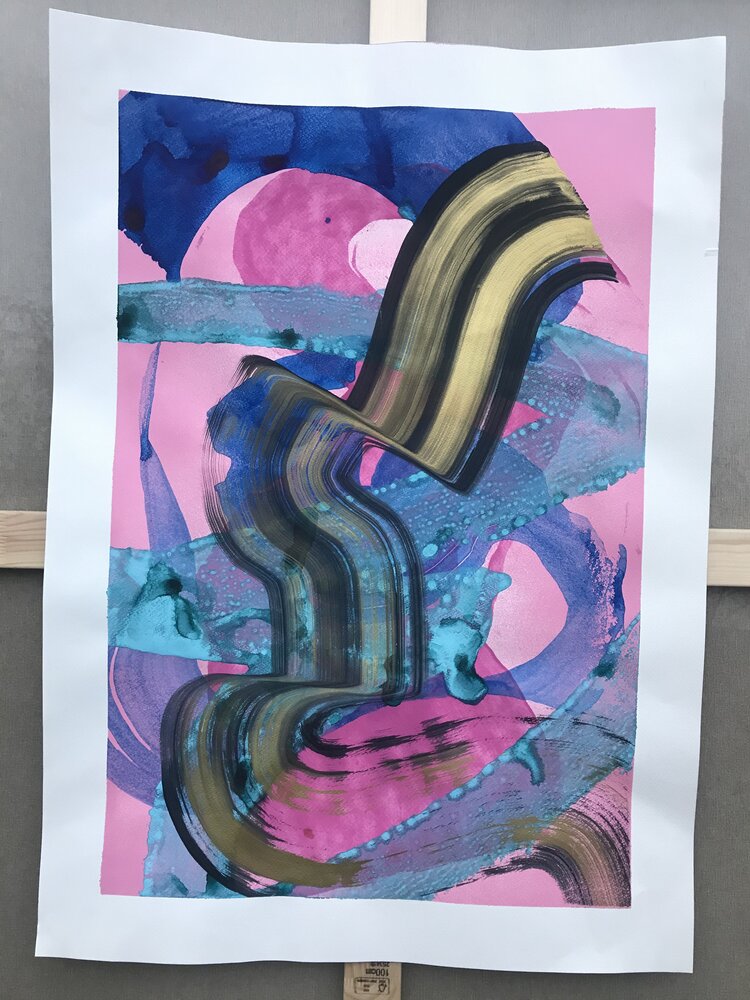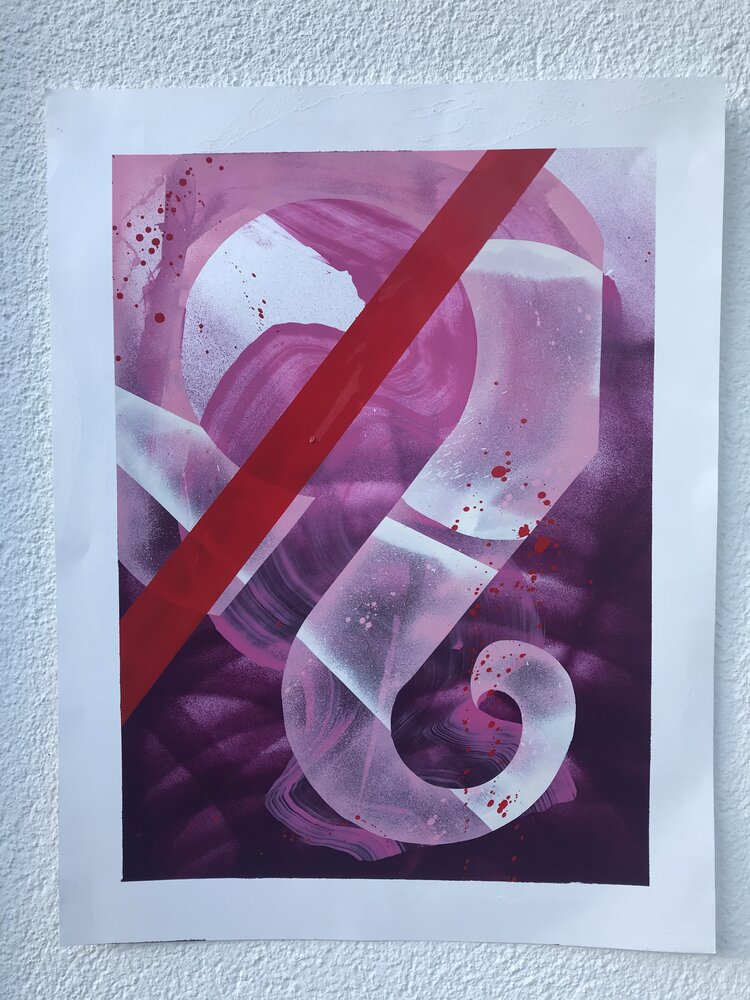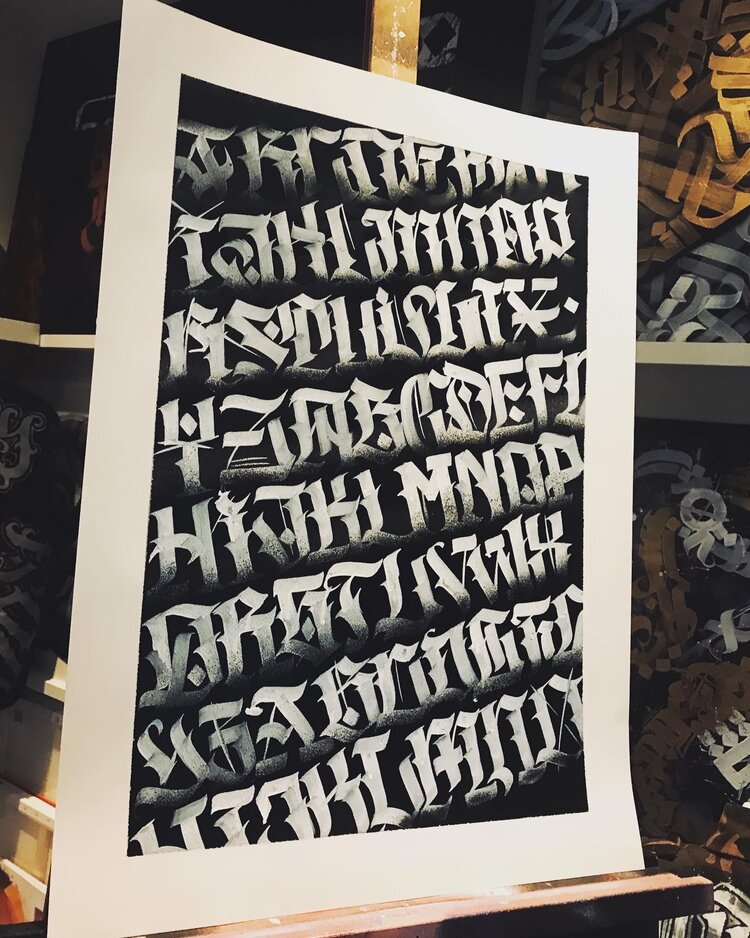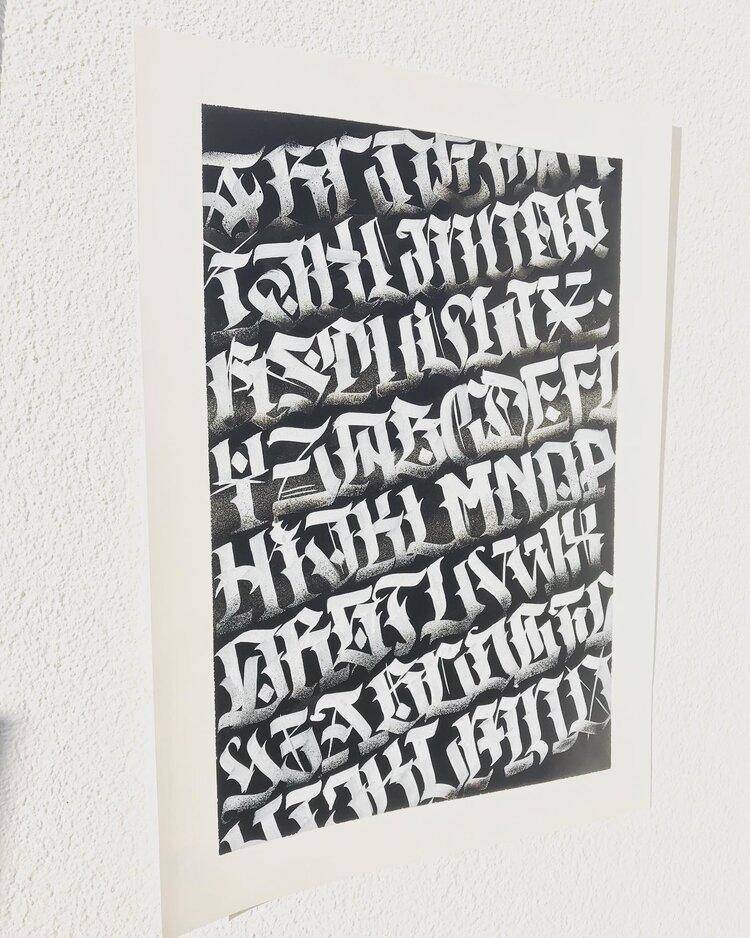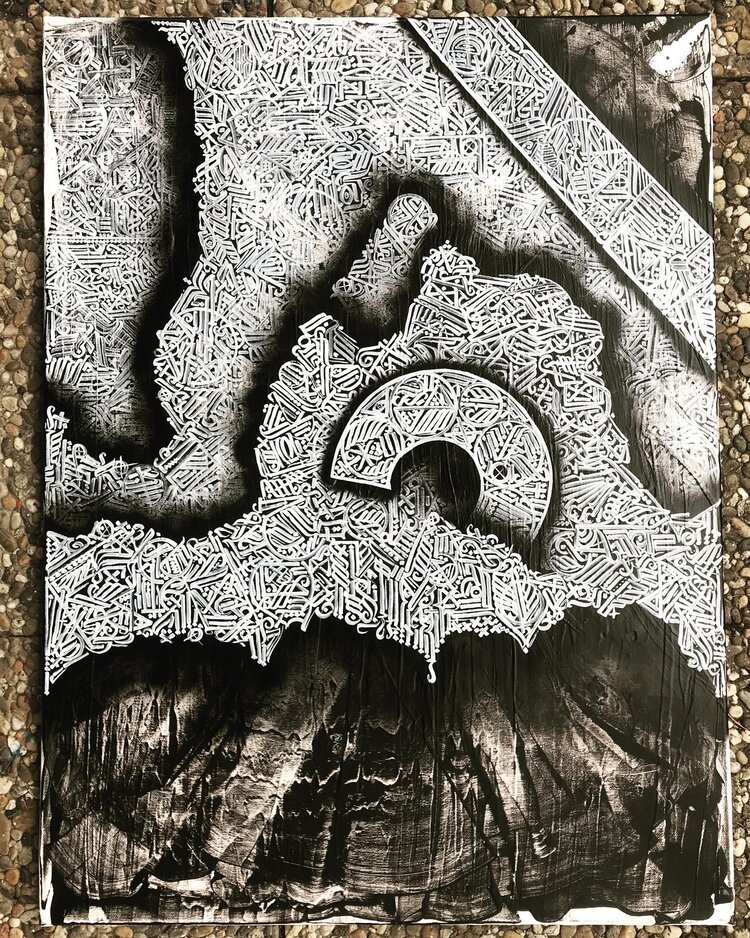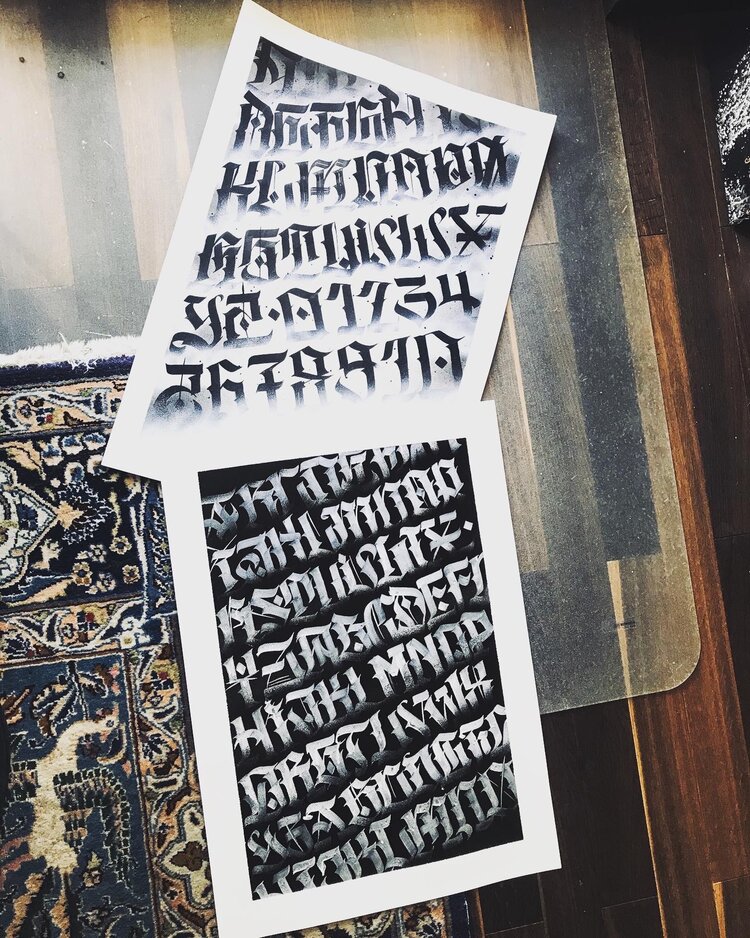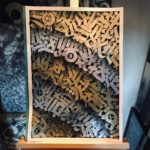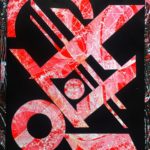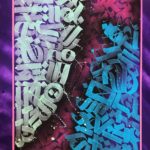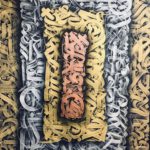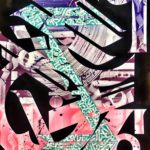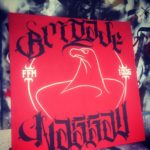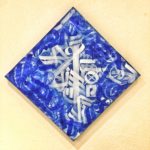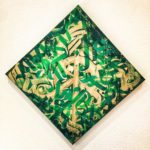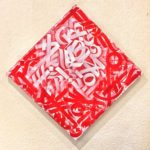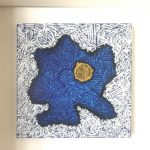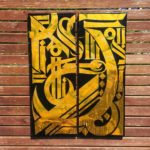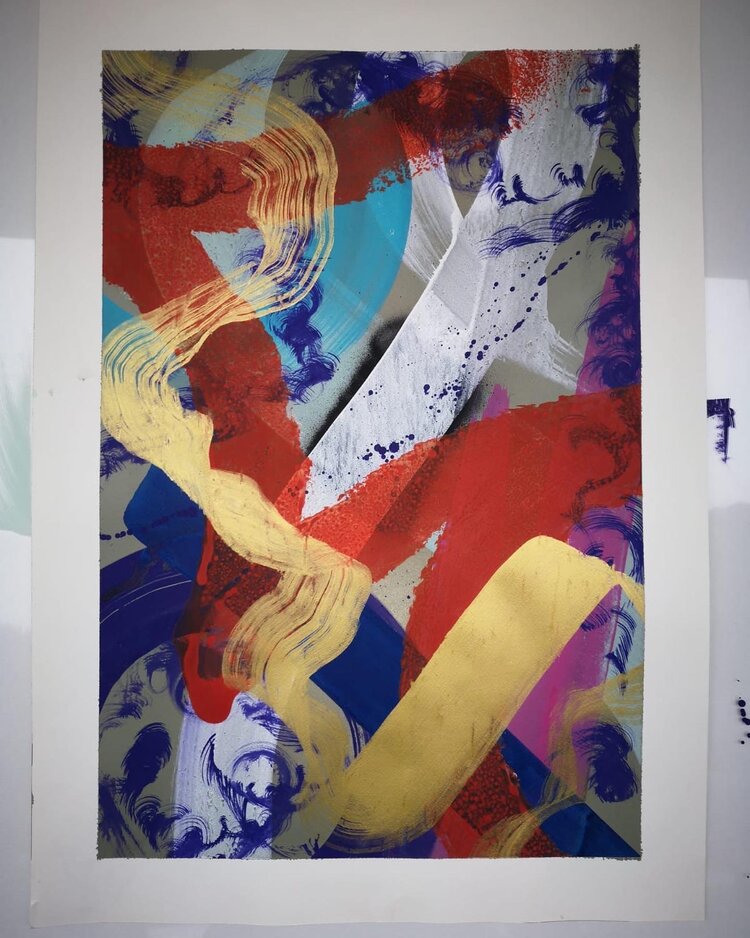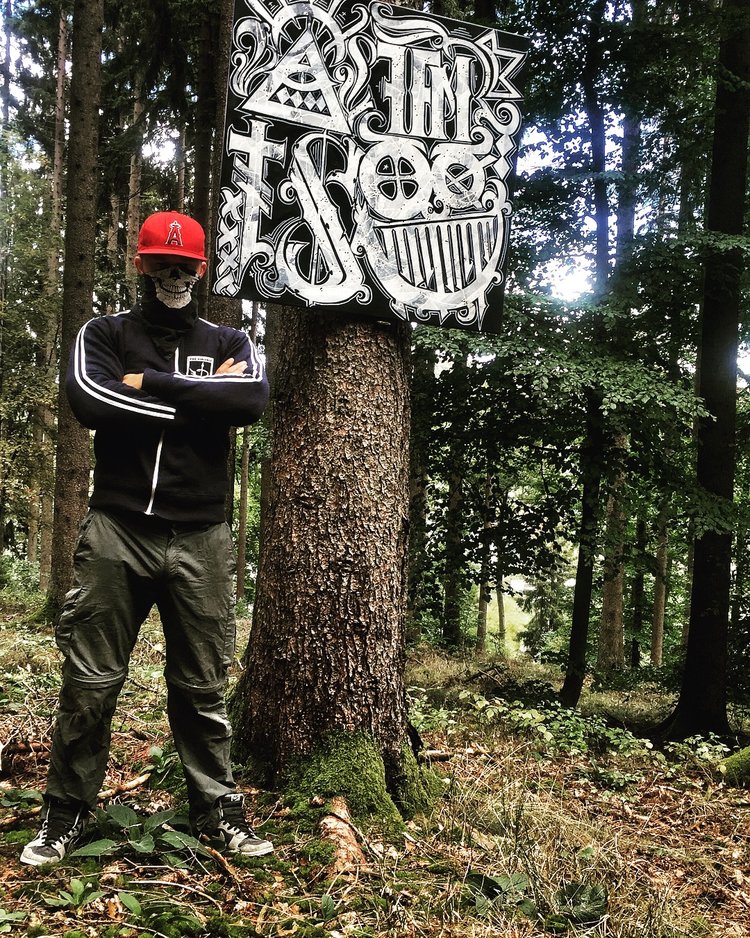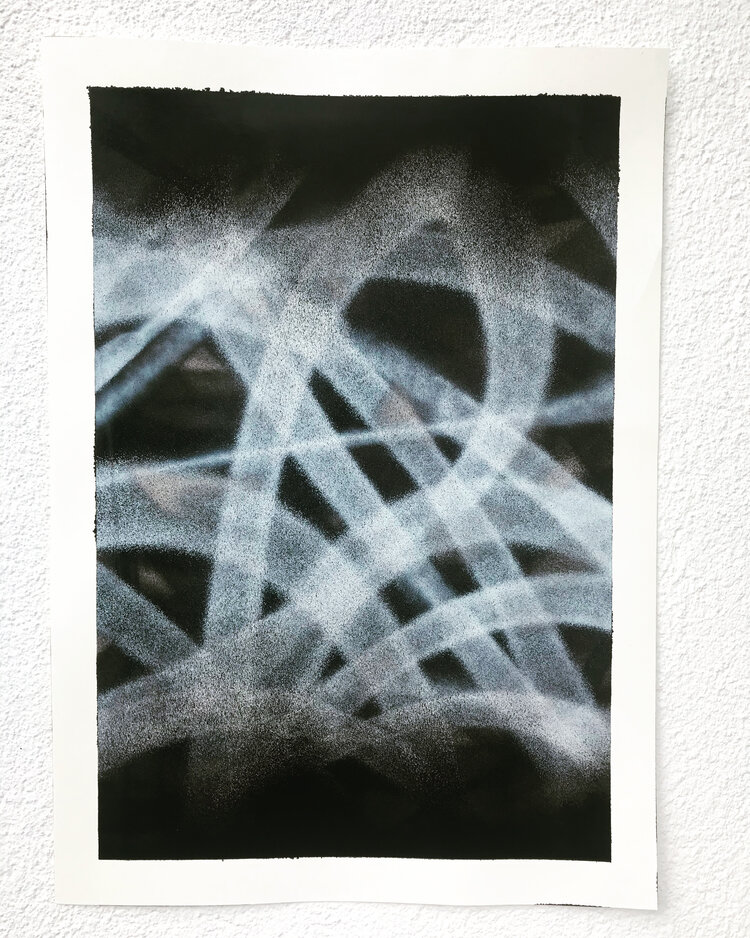The Frankfurt-based artist Lupus Alpha combines graffiti writing and caligraphy in his creative and mystical works of art. This combination is a unique art style and is called Calligraffiti. When tagging, one usually uses a marker, when graffiti the spray can and when caligraphy often the brush. With Calligraffiti, you use virtually everything together or build your personal tools like Lupus. The self-taught artist has acquired the techniques with plenty of enthusiasm himself and now has a wide arsenal of painting instruments and drawing equipment. This ranges from brooms and rakes to hairdryers. Great works of art are created through a space-filling collection and abstract elaboration of lettering.
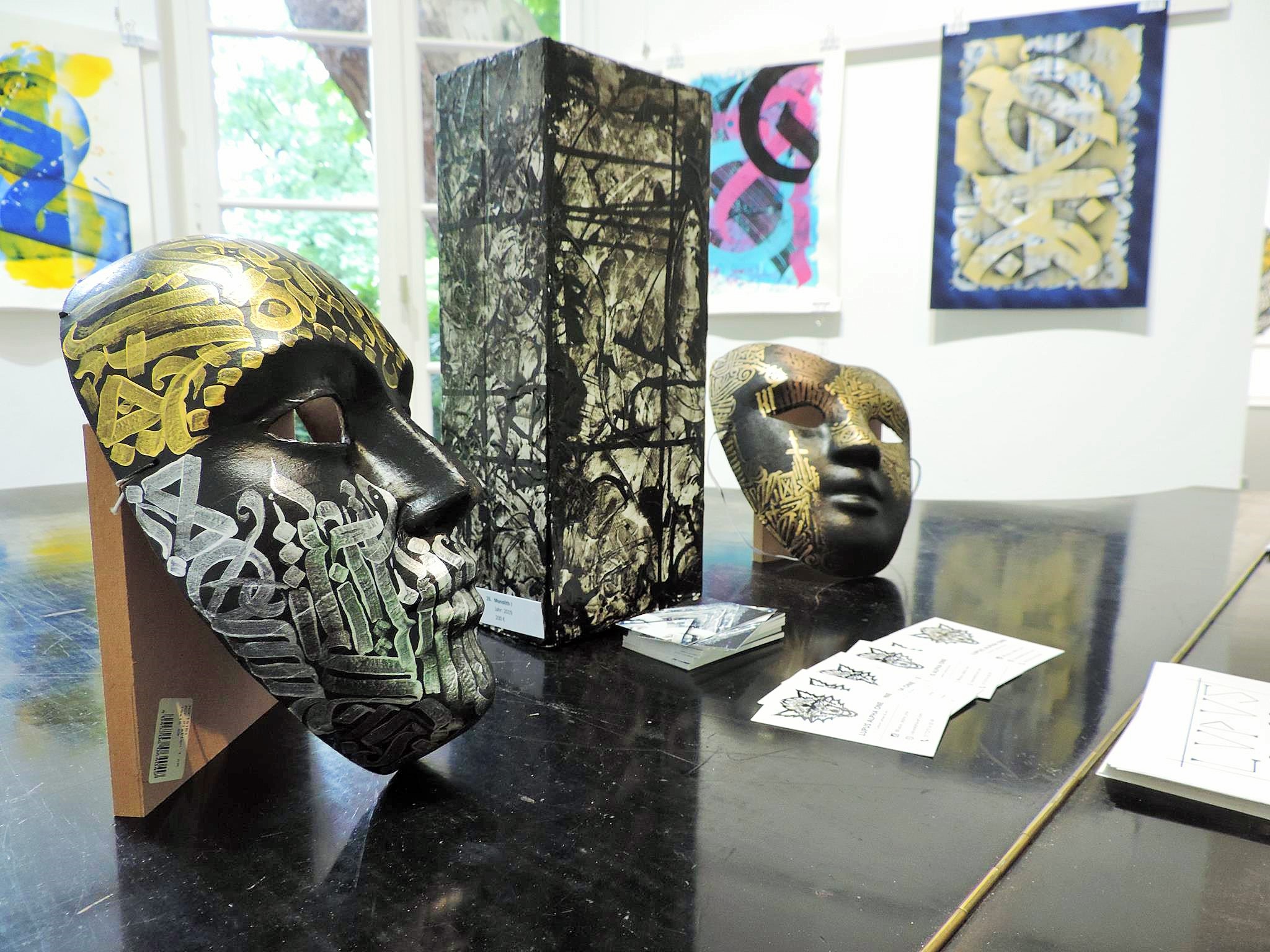
Lupus began with tagging and graffiti in his youth, but in 2015 he got in touch with Calligraffiti and calls himself a professional Calligraffiti artist by 2017. Since then, he has designed more than 30 of his personal alphabets and developed his own individual style. At an exhibition in 2019, the focus in his works was clearly on a connection to the Maja or Aztec culture. You can find a lot of gold and black or pyramid-like and relief-like constructions. In his current works he has expanded the color palette and now there is also a lot more different paint.

In July, Lupus Alpha had a solo exhibition with a large number of completely new drawings in the Nebbien Garden House of the Art Society in Frankfurt. A great opportunity to visit the artist directly on site and to record an interview about his work. The podcast is in German, but in the following the conversation is also written and translated into English. In between you will find countless fantastic works by Lupus Alpha.
Tell us something about the art of calligraffiti and what the whole thing is. You also said earlier that this has been around for ages, so almost as long as there are already people and writing.
The origins can be found in North Africa, especially in the Arab world. Calligraffiti has been used in an abstract way to make backgrounds of canvases or house walls. This means that you simply took the Arabic script, for example, and took it as a background on mass. Or that different words from the Arabic have been embellished. These are now the premature backgrounds or the origins of this form. It has now become really prominent in the western world around 2007 by the artist Niels Shoe Meulmann. This is a graffiti writer who then brought the calligraffiti of that time into the current urban form it now has. The art form itself is represented worldwide. There’s a huge community. There are things from the caligraphy, whether this is the Arabic one or whether this is the Asian one, that is up to the artist. Everybody does their own thing. And of course, that’s either bombed or painted on roofs or walls or any other background. And that’s the graffiti aspect that makes up the whole word.
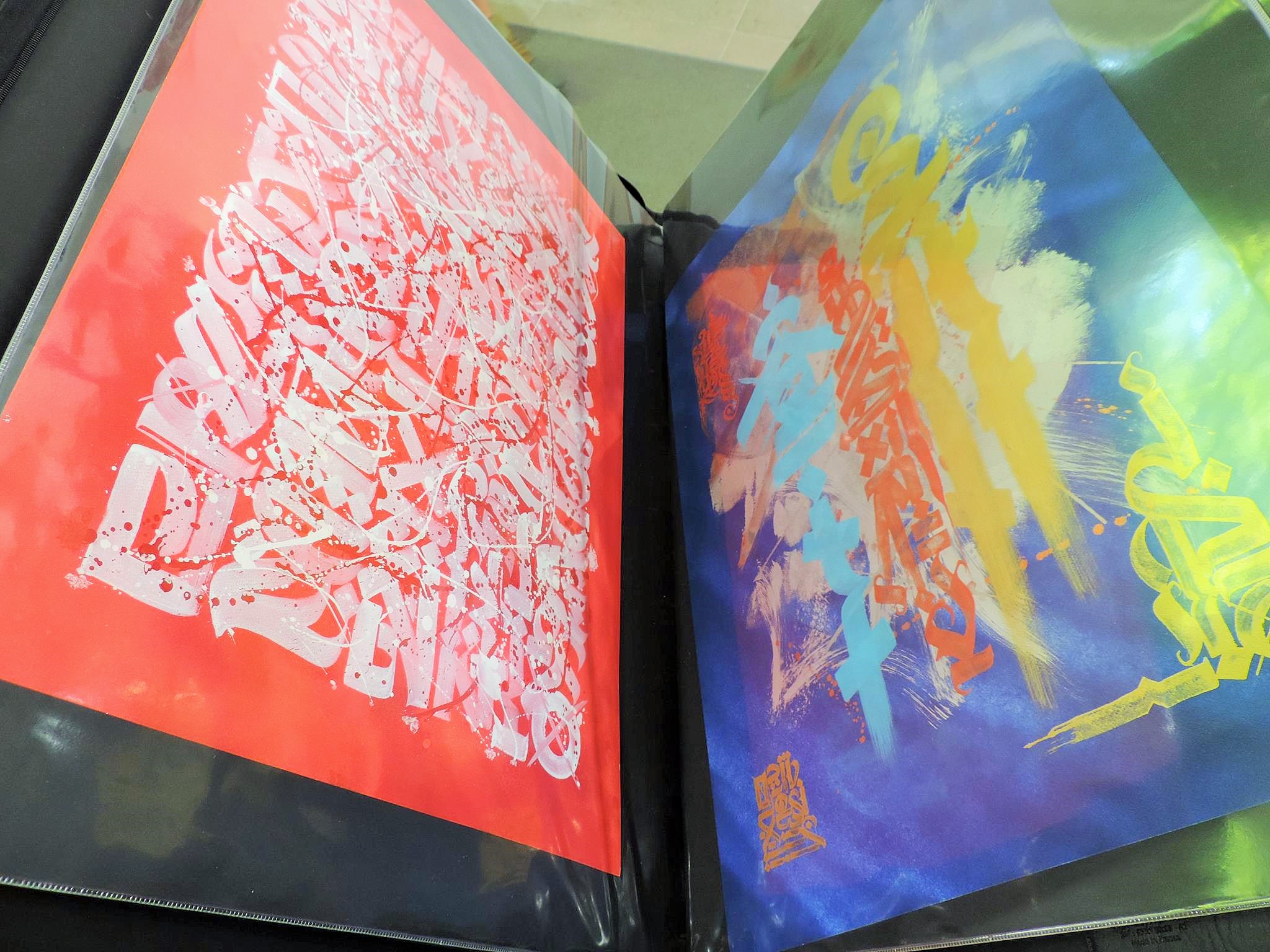
A little more to you. When did you start painting calligraffiti? I’m guessing you probably started with „normal“ Graffiti first. So with tagging and these other things that you already know. Then how did you get into the Calligraffiti?
Yeah, you guessed right. I started painting at the age of 14 in Frankfurt. First with tagging and later with the can. Well, I’ve always had an affinity for letters and for writing. This then rested for several years, but my affinity for letters or writing itself has continued in the background. And in 2015 I saw a video on Youtube, where someone does this calligraffiti and where he constructs a lettering with it. That reminded me of my childhood or my youth and I bought a pen and then I looked at other people and practiced first. If you are interested in something like that and then look, then it goes deep into the rabbit hole. There’s a lot on the Internet, you’ll find everything. There are people who paint cars or those who paint the entire squares of several acres up to very small filigree things. So it’s wide-ranging. Yes, that was 2015. That’s when I took the pen in my hand for the first time. And in 2017 I started painting canvases. I would be a professional calligraffiti artist since 2017. So, about three years.

So tagging, that’s what you usually do with a pen or a marker. Then graffiti with a spray can. Now I’ve seen many of your works, and then you started using the brush. Caligraphy is traditionally done with a brush.
That’s right. So, of course, you can do a lot and everyone has different tools, but things that overlap in the calligraffiti are the markers or the brushes. Personally, I’m more of a traditionalist. So markers are great to work very clean, very mechanical. But sometimes it has to be a little softer and a little more yielding and there is better with dynamic hand movements or body movements of the brushes. It also results in a more organic result. You really see the energy that goes into the swing and that is sometimes not possible with the marker, because then the ink runs out or because the felt is already broken. But everyone has his tools. I also work partly with things I built myself. Lately, I’ve done very little with brushes, but I’ve been working with rake, for example.
What’s that? A rake?
So this is kind of like a windshield wiper. Or you can do a lot of things with the broom. Or with coarse brushes. But what remains is definitely that you also do different things with the spray can. This means that it is best to have a wide arsenal of tools and practice a lot with them. Then it’ll be something at the end of the day.
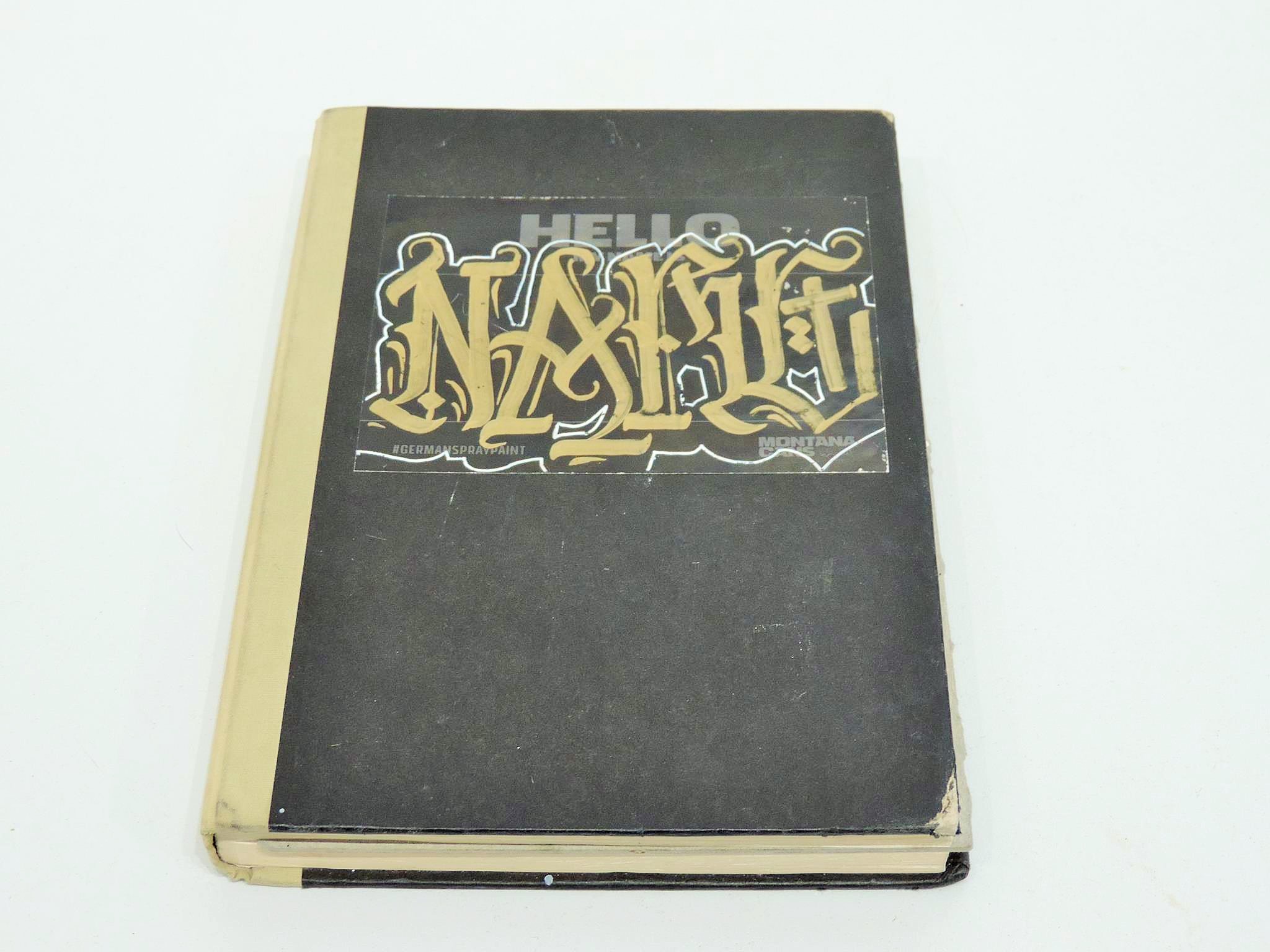
What I’ve seen so far and what you’ve shown me, you’re really using everything. In your sketchbook there you had drawn such coats of arms or logos, you did that with ballpoint pen. And then there are pictures where you just mixed everything. So mixed media. Spray can and markers and brushes and other linked together.
Exactly, that’s right. In the beginning, this causes a very big headache, because you try to master a tool. But then when you have mastered that, then more and more come to it, because at some point you are also bored by the one tool. And then, after a while, you have a lot of tools you’ve mastered, or let’s say you know what effect it has. And then you try to combine it all. This also opens up new possibilities as soon as a new tool is added. At the moment, for example, I often use a hair dryer. So a hair dryer.
I’ve been to an exhibition of yours before. I found that your works were very much based on the Maja culture or Aztec culture. Precisely this one drawing with the name “Quetzacoatl”, that’s like a pyramid that comes out of the picture almost in a multidimensional way. Of the colors it was also much with black and gold. Now in this exhibition you have hung up completely different works. So also very shrill and colorful things, also a lot with pink and with fresh and intense colors.
Yes, that’s right. We have now tried to show a larger bandwidth. Because of course I love gold, black and white. But then you have to develop at some point. My girlfriend encouraged me to expand my color palette and I have now tried several colors. I don’t know anything about color science, it’s more intuitive. And it is now partially very candyshop moderately and candy-like. But as an artist, I think you should not only think about what you are good at, but also get out of the comfort zone and try something else.
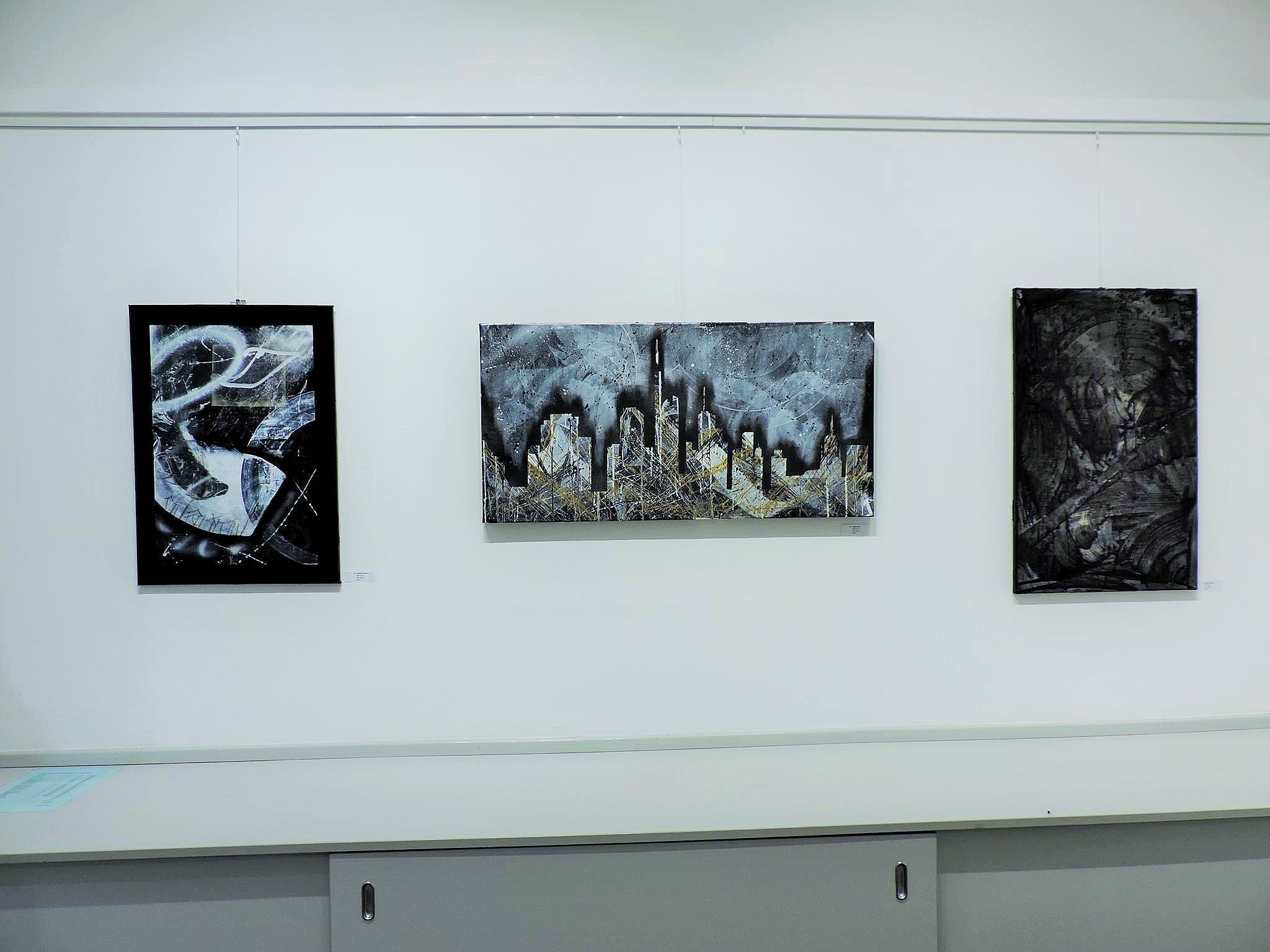
I have now seen a lot of different works in the current exhibition. Yes, some are very colorful and candyshop moderate, but there are also many where you have worked heavily with red. Some have a positive effect, so it’s the one with “Love”. But there were others who reminded me more of negative things like war or chaos and murder and manslaughter. But I think it’s also up to each person what you see in it, because it’s abstract art and a huge bead of signs, structures and forms. You’re not directly pretending, but it’s a very subjective perception of it.
Yes, that’s right. There are pictures – as you said – where it looks like a butcher’s. But in reality, I had a good day there. That doesn’t necessarily mean I was loaded with negative emotions when I painted it. Of course, there are also such pictures. It’s also always funny and interesting that many people see different things in the pictures. No matter who you show it to, everyone sees something different. Some people see animals, demons or angels or faces, so all sorts of things. That’s the beauty of the abstract calligraffiti and not the structured one, that you can experiment and that at the beginning you don’t really know what will happen later when you start painting. That you just put paint on the brush and hope for the best. This is not quite the case with structured calligraffiti, for example, because you actually have a plan of what you want to do. That’s the good thing about the abstract, that you can make a little bit of a mess.
Tell us a little more about caligraphy. So you’ve already told us a lot about graffiti and that you used to paint and tag. But did you really practise caligraphy and do you know caligraphy? Or did you rather acquire a similar-looking style? So you can write this lettering and also a second question: Do you write something in your pictures or is it just a wild arrangement? So there’s hidden messages in there?
So the first question is, for example, if I am trained in classical caligraphy typeface: No. I taught myself everything. What would caligraphy script be? So when it comes to caligraphy, for example, some people think of Japanese writing. But in the German area it is more Gothic and fracture. So from the type face, from the font used in the caligraphy. For example, font from old Bibles or old German book printing. So I didn’t learn that, but if you’re interested in it and if you want to practice something, then you’ll find enough examples of writing and alphabets that you can then re-paint. You learn the craft, so to speak, but your own style has other influences. So it’s gothic and fracture, but also influences from cholo chicano – graffiti, which has been around in Los Angeles since the 70s. So actually gang graffiti. And then there’s a couple of things from the tagging of yesteryear. It’s a mishmash, it’s an alphabet of its own.
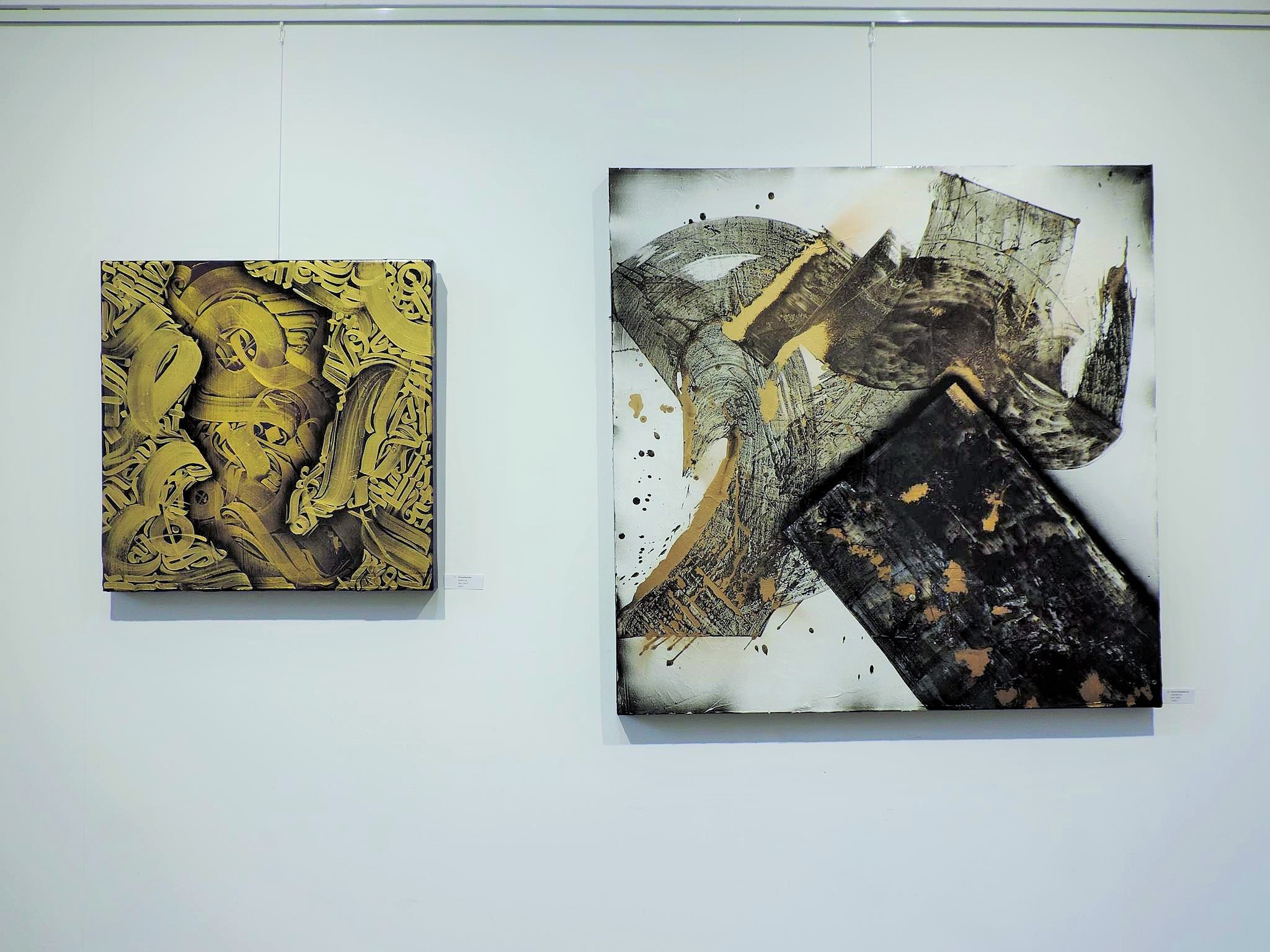
You’ve almost developed your own style for the letters. You may make the letters in different versions, but in your own style.
Yes. I also practice alphabets regularly, but my own alphabets. That means I think I have a total of 30 different alphabets at home. I’ve never published them either. Maybe I’ll make a book like that for tattoos. It’s a lettering book, but that’s a different story. Now to the second question. So the second question was yes: Is there something? So there are works, there is really only abstract, there are only forms. It’s only built with shapes and there’s no message behind it. Then there are others where there is really based on a self-invented alphabet what is in it. For example, where a song is written or a poem or where a message is written. But I just don’t want to let it out and show it too much. I actually want the viewer to find out for himself what it is for him or her. I don’t always tell everything right at the beginning.
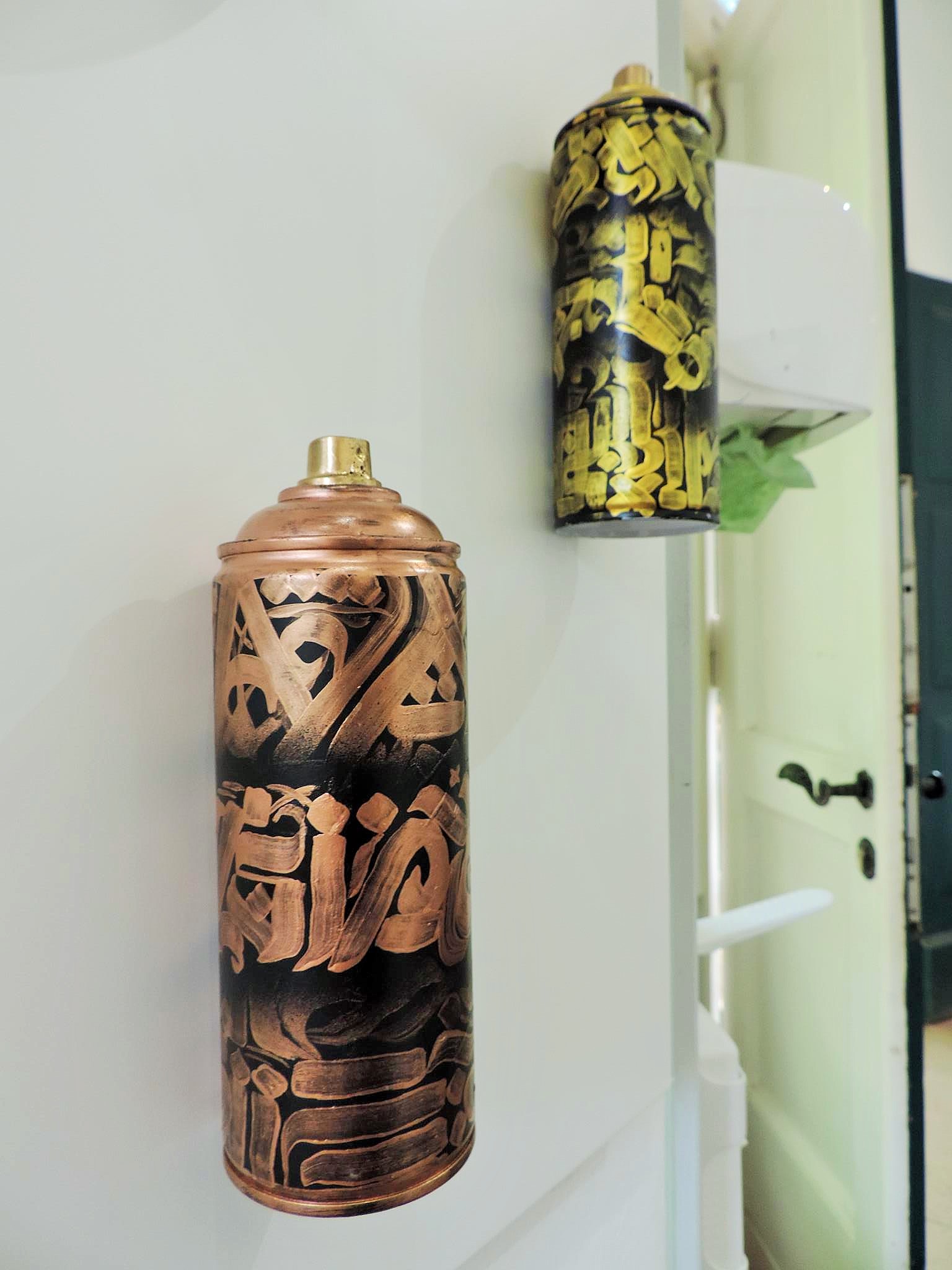
But that’s also good to arouse a bit of curiosity. So the two pictures with the “Love” and “Hope”. So that’s clear, you can see the letters very clearly. But people should come to an exhibition themselves and discover, there are still very hidden messages in some of the works.
That’s right!
When we talked about caligraphy earlier, you also mentioned Japan. That’s the first thing I had in mind. The way you know it, how you can concentrate with these brushes in Japan and paint these characters complexly on papyrus or something. But of course, with us here in Central Europe or Germany, you have to think more about these Gothic things and also about pressure. Have you dealt with it once? So screen printing or things to print? I just have this letter in my head or from the newspaper print and there you can also stamp quite well.
Yeah, yeah. I’ve been dealing with screen printing or stamps lately. I actually wanted to make stamps for the exhibition, but I didn’t finish. Yes, I’m dealing with the subject. I was also recently at the Klingspoormuseum in Offenbach, for example. But not before. So it’s really only been this way last year. But of course, these things would actually fit. I was wondering if I could make some T-shirts. But first of all, I think I would build such a screen printing machine myself. I just haven’t had the muse to get all the material and watch the Youtube video. Maybe in the future. It will definitely remain interesting, because as you have explained all this so far, you are continuously expanding your instrument arsenal.

Maybe next time there’ll be something on stamps. Which I also thought was very cool earlier, you gave me stickers. And yes, so these are quasi unique. So self-painted stickers. These are from Montane, these blank stickers. That’s when you painted something on it.
That’s right. So Eggshell stickers. For those who want to know exactly. It’s from Montana. That’s a funny thing. If you’re busy with this, you can check it out on the Internet. And yes, there is banko. Of course there are a lot of people who just tag on their stickers and I try a little bit more. I’m taking a little picture. Of course, it takes longer, but if you have glued it somewhere at home, then of course it makes a lot more of a difference.
Yes, if we go in this direction, then of course I also immediately think of Stencil. Have you done anything in that style yet?
Now, when we talk about Stencil, everyone always thinks of Banksy the same way. That’s the king’s class. No, I’m not. But I do stencils with letters. I designed skateboards, I made jackets or motorcycle trunks. Since I have written on it gestciled. I always make birthday letters with stencil for very good friends on birthdays. So with Stencil I have now tried extremely much and it is definitely a highly interesting medium. Who knows what else I can do with it.
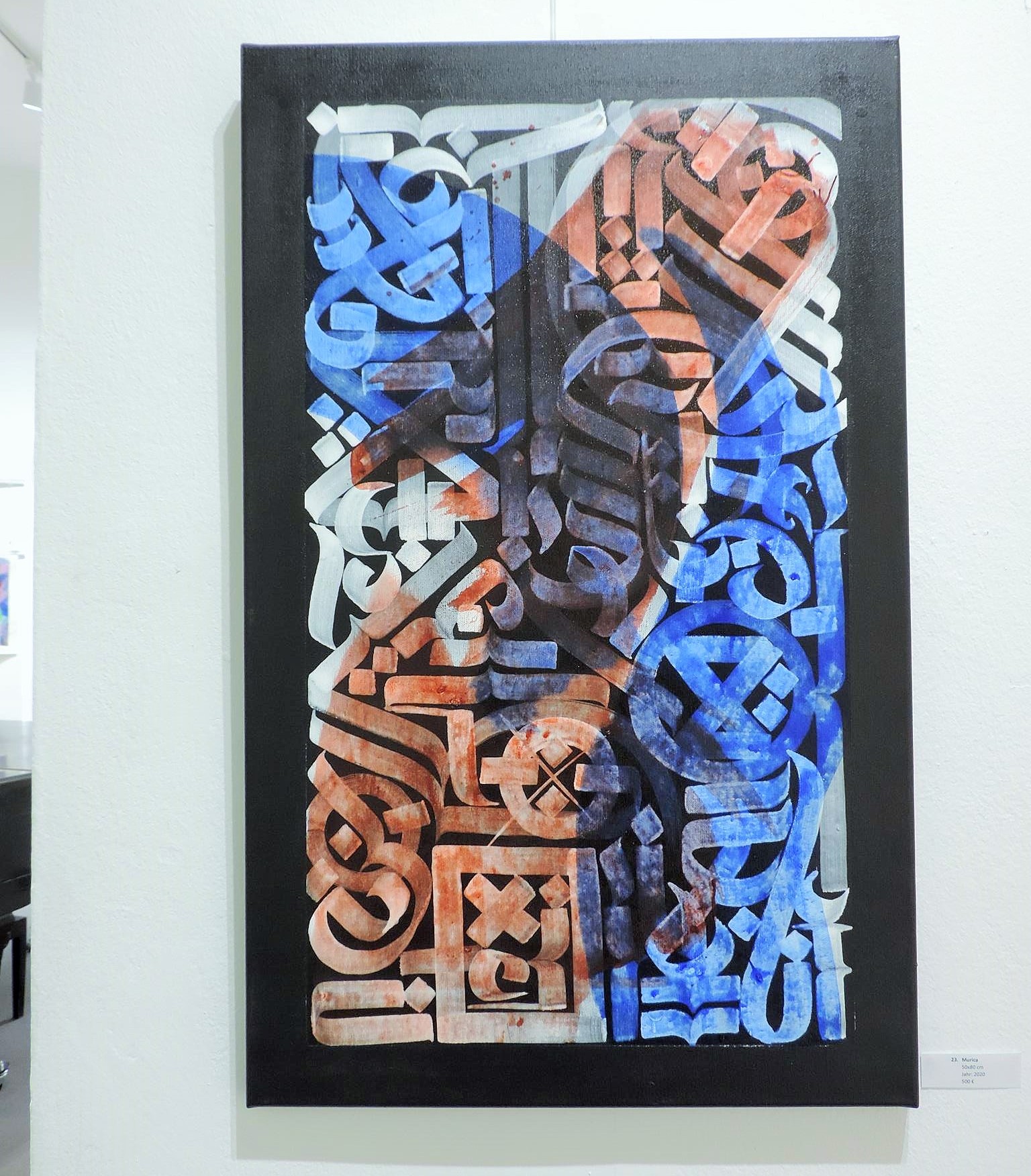
For the people who don’t know Stencil yet: So in principle and to explain it simply, it’s just a work with stencils. You make a stencil of something and then just spray the surface where there is no cardboard or whatever material. Then you have just this sprayed through on a surface behind it. You can do this with one color, but you can also put different stencils on top of each other.
So first the one surface with black, then the other with red and so on. In this way, even more complex images can be created. And you can do it with different figures, for example, or just like you do with letters and lettering. And I do it like that. So when stencil, many people do it so that you can use the template again afterwards. I’ll do it differently. For example, I glue a canvas with crepe paper or tape and sometimes the letters on the tape and then cut them out with a scalpel and then spray with different colors on the canvas, so to speak. Then I’ll rip off the entire tape, and then you’ll have the finished product. But that stencil, it doesn’t exist anymore. It was on the tape and you can’t pick up the tape.
In other words, this is the reverse of how many stencil artists are now proceeding. So the one with the stencil. They cut something out and spray the whole thing that’s cut out and you take what you want to cut out, glue it on.
Exactly, that’s right.

At your last exhibition here in the Nebbien Garden House, there was this correspondence with the Czech artists for the group exhibition. You were seven and exhibited here together. They came from Prague and the Czech Republic and presented their works here and the idea or plan was that you would go from Frankfurt to Prague. But because of Corona, unfortunately, this could not take place. But you mean you’ve already set your sights on an alternative date in the fall.
Yeah, so I don’t know too much. But it was suggested to me that in September or October the exhibition might be able to catch up in Prague, the Czech side and in Bratislava. It’s like a lot of things. Many things have been cancelled or moved backwards by Corona. But we are working to make it possible for us to do so in the autumn in the two countries. So as soon as we can get in, actually.

Are there any other projects that are still pending?
Yes, I still have a few locations in the back hand, where exhibitions are planned. Maybe even standing mini-exhibitions in shops or pubs. However, this depends of course on the current Corona situation. I don’t have any fixed dates. And I’m flexible and I just look at what’s coming.

For the listeners who are interested in the whole thing, they can already look at the computer or mobile phone. You are mainly on Instagram on the net, on less Facebook, but also there. And of course your website. You’ll find a lot of your work there.
So if you want to have a rough overview, you can of course go to Instagram. The user name is “lupus_alpha_one. ” This is for Instagram, but there is also a website called www. lupusalpha-art. com. I use Facebook the least, but there it would be “LupusAlphaCalligraffiti”.
Tell us something else about your name. Lupus Alpha. So Lupus is the wolf. Does this have anything to do with the animal, and then Alpha means you’re the Alpha Wolf?
It actually has to do with my person and with my character. So that I take the role of Alpha Wolf. For example, with us now in the group or with us in the circle of friends. But that also has to do with the fact that I am the oldest or have travelled the furthest of all. But yes, that’s the thing. Well, I’m the one taking care of the others. You’re gonna need a name if you do anything. You also need a name if you don’t want to use your own or if you want to throw it on the internet. And that was the best of all the names I’d picked out.
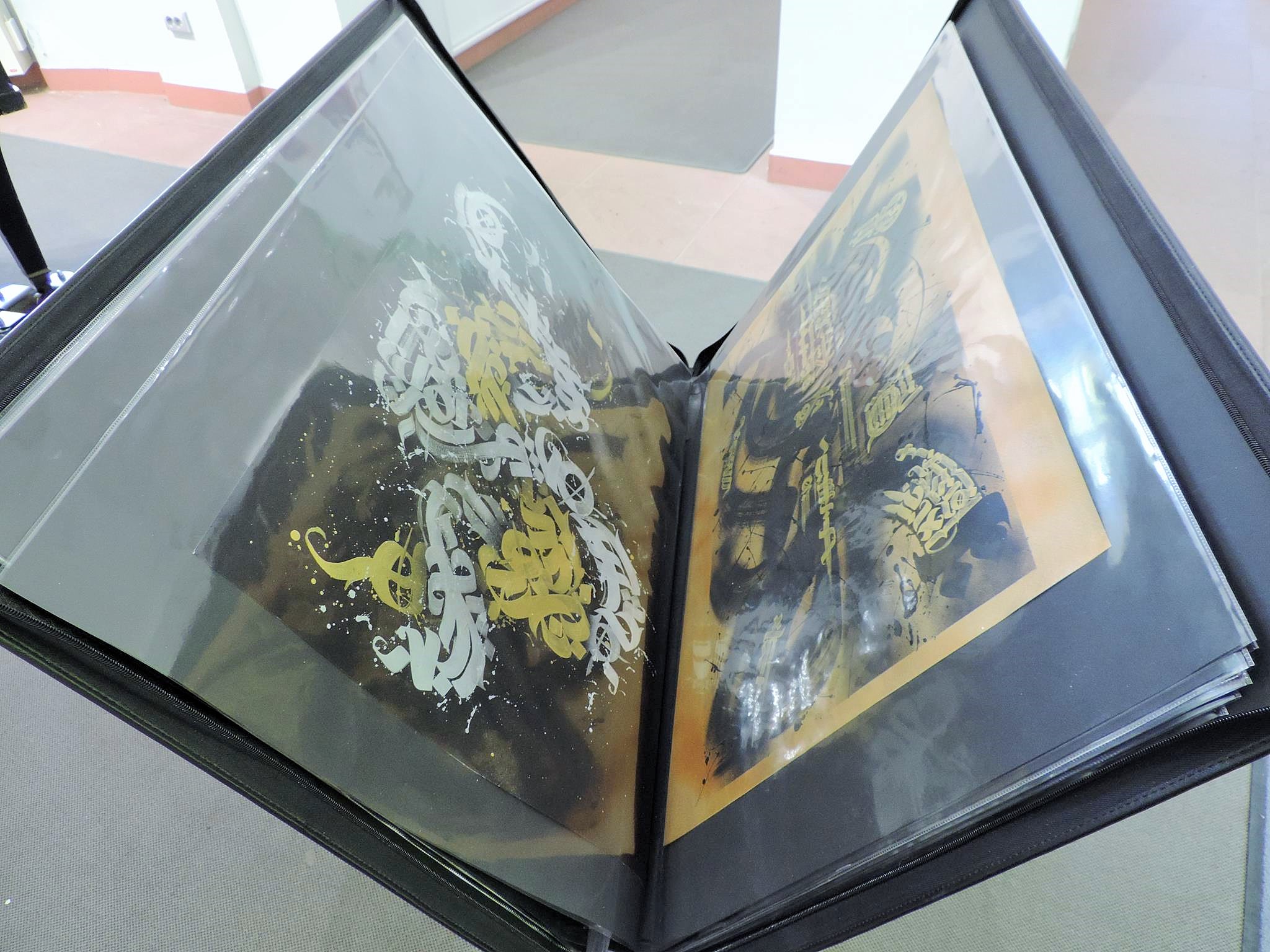
It’s always such a development phase until you have a name. And you also try out and you have to see yourself in the name. You must like it, too, and it must fit.
And whoever painted graffiti knows this: you never stick to the first name you paint.
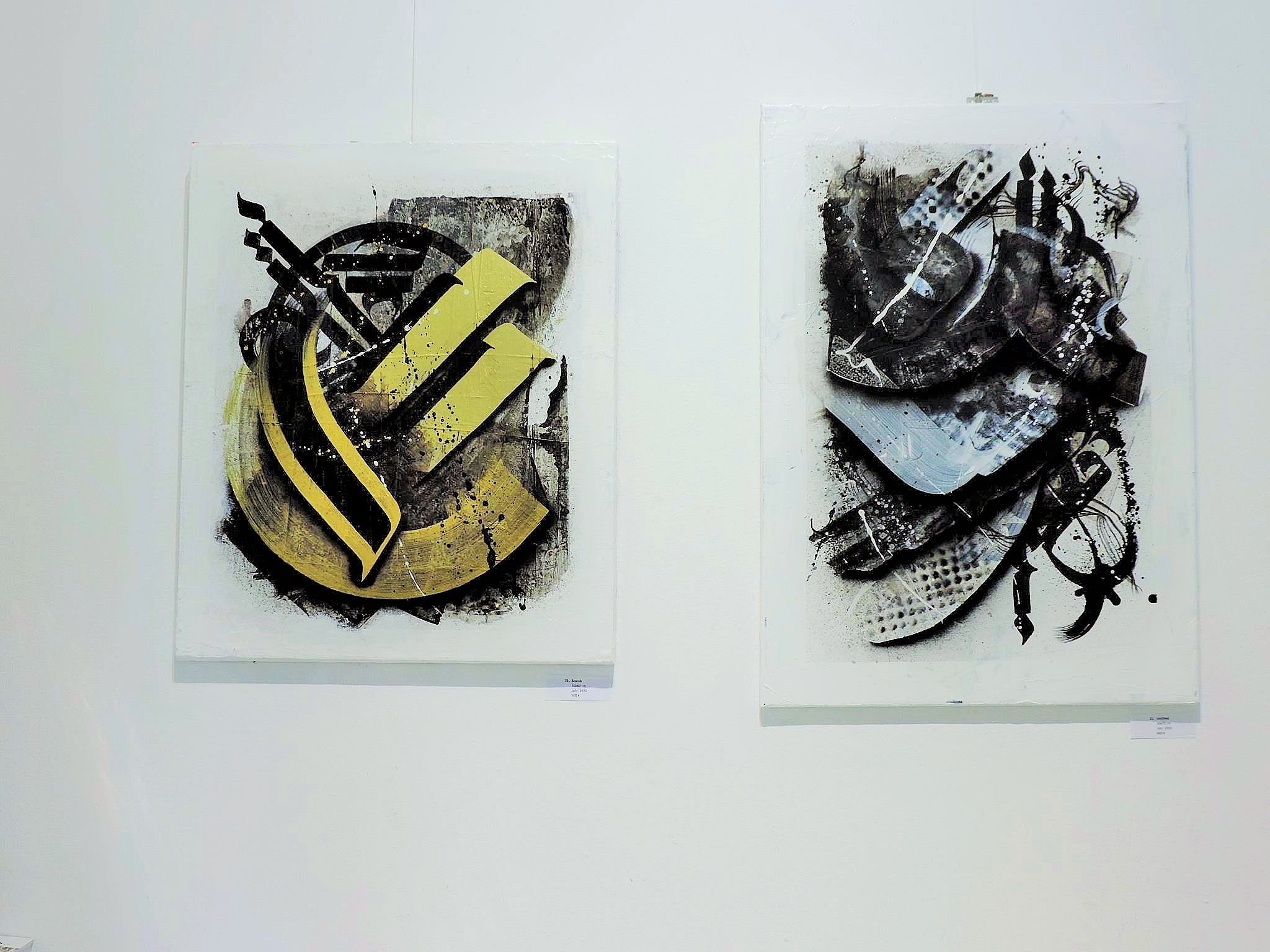
Above all, you can always greet all the other past names on the painted works!
That’s right! 🙂

People are certainly also interested in whether you can be seen live at work somewhere. Maybe here somewhere in Frankfurt. But you grew up in the city, but right now you’re in the Taunus. You currently have a studio there.
Yes, I grew up in Frankfurt, but at the moment it is better to paint in the Taunus. I’ve got more room there. I’ll say it splashes and the paint flies back and forth everywhere. And it’s not so practical in a smaller studio. That’s why I have an outdoor area now. So I paint in the Taunus, where I live right now. And there’s an outdoor studio and an indoor studio. And yes, of course, if someone is interested in looking at the times, they can then gladly make an appointment. But yes, I can do that and all the works are created there.
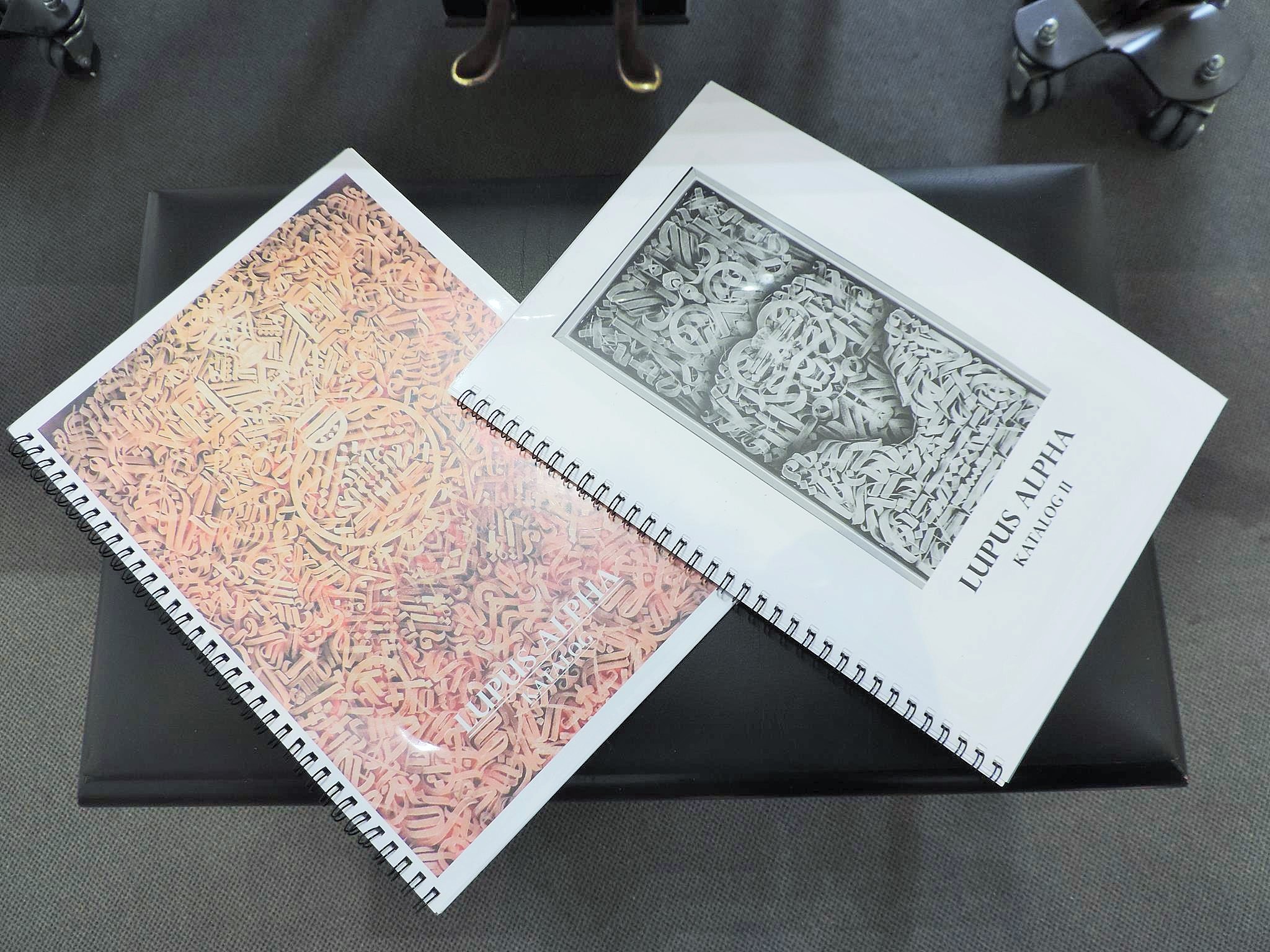
INFOTHEK
![]() Contact: https://www.lupusalpha-art.com/contact
Contact: https://www.lupusalpha-art.com/contact
![]() Website: https://www.lupusalpha-art.com
Website: https://www.lupusalpha-art.com
![]() Facebook: https://www.facebook.com/LupusAlphaCalligraffiti
Facebook: https://www.facebook.com/LupusAlphaCalligraffiti
![]() Instagram: https://www.instagram.com/lupus_alpha_one
Instagram: https://www.instagram.com/lupus_alpha_one

